Get work done right, and right-on-time with our industry leading BPM platform.
120 Must-Have Business Tools to Crush Competition
You need business tools. No, seriously, you need business tools. And I mean online business tools, not the rolodex still sitting on you old boomer boss’s desk.
For business owners, they make all the difference in organizing and streamlining the operations of, well, everything! Though they cost money, they ultimately save you way more.
But when starting a business, when organizing a business plan or remote team, or when figuring out which tools to go with and which ones will work for your specific business needs, it can be pretty overwhelming to figure out which ones are best. Which ones you actually need and which ones you can leave behind.
So to help you out, I’ve put together a monster list of the 120 best business tools out there broken down into the following categories:
- Workflow management
- HR management
- Customer service
- Business analytics
- Accounting
- Marketing
- Sales
- Email management
- Social media management
- Communication
- Website builder
- Time management
- Document management
- Payment processing
- Inventory management
So go ahead and take a gander at the different categories you know you need and find the tools that will help your business thrive.
Onward!
Workflow management
Process Street

Process Street is a powerful business process management platform that simplifies workflow automation. It enables organizations to create, track, and optimize recurring processes through intuitive checklists. With features like conditional logic and AI-generated workflows, Process Street enhances efficiency, accountability, and collaboration, making it an invaluable tool for businesses striving for operational excellence.
Best for: Workflow automation.
Key features:
- Checklist automation: Create and automate dynamic checklists for recurring processes.
- Conditional logic: Customize workflows with conditional logic based on responses.
- Collaborative workflows: Facilitate team collaboration on tasks and processes.
- Integration capabilities: Seamlessly integrate with tons of apps and tools.
- Task assignment: Assign and track responsibilities within processes.
- Data collection: Gather and store data through forms within checklists.
- Reporting and analytics: Generate insights with analytics on process performance.
- Version control: Maintain and track versions of checklists for auditing.
- API access: Connect with other applications through APIs.
- Document storage: Attach and manage documents relevant to processes.
Pros:
- Intuitive interface makes it user-friendly.
- Offers secure data handling and storage.
- It has a mobile application.
- Custom automated workflows can be made with AI.
- It has lots of premade workflow templates to choose from.
Cons:
- There is no free plan.
Pricing: Process Street pricing page.
Asana

Asana is a versatile project management software designed to streamline team workflows. It enables users to organize tasks, set priorities, and track project progress in real-time. Asana empowers teams to enhance productivity and achieve their goals efficiently.
Best for: Project management.
Key features:
- Task management: Organize tasks and projects efficiently.
- Project timelines: Visualize project timelines and milestones.
- Due dates and priorities: Set deadlines and prioritize tasks.
- Attachments and comments: Share files and communicate within tasks.
- Customizable workspaces: Tailor workspaces to fit team needs.
Pros:
- Enables the establishment of task dependencies for better planning.
- Frequently introduces new features and improvements.
- Provides a functional free plan for smaller teams.
- Users can monitor and manage multiple projects in one view.
Cons:
- More advanced features are available in premium plans, which may be costly.
- Might feel too robust for straightforward task management.
Pricing: Asana pricing page.
Trello

Trello is a popular online tool that utilizes boards, lists, and cards to streamline project management. It simplifies tasks, fosters team collaboration, and visualizes workflows in an easy-to-understand format. Trello’s intuitive design empowers teams to organize and prioritize work seamlessly, making it a go-to choice for various projects.
Best for: Team collaboration.
Key features:
- Boards, lists, and cards: Organize tasks hierarchically.
- Drag-and-drop: Intuitive interface for easy task management.
- Labels and tags: Categorize and color-code tasks for clarity.
- Power-ups: Extend functionality with integrations and automations.
- Activity log: Track changes and updates on boards.
Pros:
- Adaptable to various project management styles.
- Boards and cards offer a clear visual representation.
- Users can create boards tailored to their needs.
- Super budget-friendly, which makes it great for small businesses.
Cons:
- It has limited control over data security compared to self-hosted solutions.
- It has very limited automation features compared to other tools.
Pricing: Trello pricing page.
Monday.com

Monday.com is a dynamic work operating system designed to streamline collaboration and project management. It provides a visual and customizable platform for teams to manage tasks, projects, and workflows efficiently. Monday.com helps teams enhance communication and productivity while adapting to diverse work processes.
Best for: Agile project management.
Key features:
- Workspaces: Create customized workspaces for different projects.
- Boards: Visualize tasks and projects through customizable boards.
- Pulses: Individual task cards with detailed information.
- Timeline view: Display project timelines for better planning.
- Automations: Streamline workflows with automated actions.
Pros:
- Attach and share files directly within the platform.
- Real-time collaboration with team members.
- Create and customize visual dashboards for insights.
- Responsive customer support for assistance.
Cons:
- The free plan has very limited features.
- It doesn’t offer an offline mode.
Pricing: Monday.com pricing page.
Airtable

Airtable is a versatile collaboration platform that combines the simplicity of a spreadsheet with the complexity of a database. It empowers users to create flexible databases for various purposes, from project management to content planning. With a visually appealing interface, Airtable fosters collaboration, creativity, and efficient information management.
Best for: Team collaboration.
Key features:
- Flexible database structure: Create databases tailored to specific needs.
- Grid view: Visualize and organize data in a spreadsheet-like format.
- Kanban view: Manage tasks and projects through customizable boards.
- Calendar view: View and organize data in a calendar format.
- Gallery view: Display records as cards for visual representation.
Pros:
- Adaptable to various use cases with flexible databases.
- Easy creation of customizable forms for data input.
- Conveniently attach files and media within records.
- Highly customizable to fit unique workflow needs.
Cons:
- Basic automation features may not meet advanced workflow needs.
- Some users express concerns about data security.
Pricing: Airtable pricing page.
Jira

Jira is a widely used project management tool renowned for its adaptability in software development. It serves as a comprehensive platform for issue tracking, project planning, and team collaboration. With its robust capabilities, Jira enables teams to efficiently manage projects, track progress, and maintain a streamlined workflow in the software development lifecycle.
Best for: Issue tracking.
Key features:
- Issue tracking: Comprehensive tracking of tasks, bugs, and issues.
- Agile boards: Scrum and Kanban boards for flexible project management.
- Roadmaps: Visualize and plan project timelines.
- User story mapping: Plan and organize user stories for agile development.
- Backlog management: Prioritize and manage tasks in project backlogs.
Pros:
- Highly customizable workflows to match project needs.
- Suitable for both small teams and large enterprises.
- A wide range of plugins to extend functionality.
- A large and active community for support and resources.
Cons:
- Some users find the interface less intuitive compared to other tools.
- Primarily designed for software development, may not suit all project types.
Pricing: Jira pricing page.
Wrike

Wrike is a robust project management and collaboration platform designed to streamline workflows and enhance team productivity. Its dynamic interface and flexible structure cater to diverse project needs, fostering efficient communication and project coordination. Wrike empowers teams to manage tasks, projects, and resources seamlessly for successful project outcomes.
Best for: Project time tracking.
Key features:
- Time tracking: Monitor and analyze time spent on tasks and projects.
- Resource management: Allocate and manage team resources effectively.
- Task management: Organize and prioritize tasks efficiently.
- Project planning: Plan and visualize projects with timelines and Gantt charts.
- Collaboration: Facilitate real-time collaboration and communication.
Pros:
- Efficient allocation and management of team resources.
- Convenient file sharing and collaboration within the platform.
- Adaptable to various project management needs.
- Seamless integration with numerous third-party apps.
Cons:
- Basic features in the free plan may be insufficient for larger teams.
- Can be resource-intensive in terms of memory and processing.
Pricing: Wrike pricing page.
Creatio

Creatio is a comprehensive low-code platform that empowers businesses to streamline processes and drive productivity. It combines CRM and BPM capabilities to enhance customer engagement and optimize workflows. With a focus on agility, Creatio facilitates rapid application development, enabling organizations to adapt and innovate in today’s dynamic business environment.
Best for: Application development.
Key features:
- Low-code platform: Enables rapid application development with minimal coding.
- Case management: Efficiently manage and resolve customer cases.
- 360-degree customer view: Comprehensive customer information for improved engagement.
- Marketing automation: Streamline marketing processes and campaigns.
- Sales automation: Automate sales processes for increased efficiency.
Pros:
- Integrates customer relationship management with business process management.
- Offers robust tools for data analysis and reporting.
- Automates and optimizes complex business processes.
- Facilitates efficient customer service management.
Cons:
- Setting up complex customizations may require technical expertise.
- Some advanced features are available only in higher pricing tiers.
Pricing: Creatio pricing plans.
HR management
BambooHR

BambooHR is a cloud-based enterprise software suite offering a unified platform for HR, finance, planning, and analytics. Renowned for its user-friendly interface and scalability, BambooHR empowers organizations with real-time insights, agile planning, and efficient workforce management, making it a comprehensive solution for modern business needs.
Best for: Overall HR management.
Key features:
- Human capital management (HCM): Comprehensive tools for HR functions, from recruitment to talent management.
- Financial management: Streamlined finance processes, including accounting, procurement, and analytics.
- Workforce planning: Agile planning tools for optimizing workforce efficiency.
- Payroll management: End-to-end payroll processing and compliance features.
- Time tracking: Accurate recording and management of employee work hours.
Pros:
- Integrates HR, finance, planning, and analytics in a single cloud-based solution.
- Frequent updates and improvements to keep the system current and efficient.
- Robust security features to protect sensitive data.
- Supports multinational organizations with diverse regulatory requirements.
Cons:
- You need to contact sales to get pricing.
- Requires dedicated resources for maintenance and system administration.
Pricing: Workday sales page.
Workday

Workday is a cloud-based human resource management system that revolutionizes HR processes. Renowned for its intuitive interface and unified platform, it simplifies HR tasks from recruitment to talent management. With a focus on user experience and innovation, Workday HR empowers organizations to enhance employee engagement and streamline HR operations seamlessly.
Best for: Recruitment.
Key features:
- Recruitment management: Streamlines the hiring process from job posting to onboarding.
- Employee self-service: Allows employees to manage personal information and tasks.
- Benefits administration: Manages employee benefits and open enrollment.
- Performance management: Facilitates goal setting, feedback, and performance reviews.
- Compensation management: Handles salary structures, bonuses, and compensation planning.
Pros:
- Manages employee attendance, time-off, and leave requests.
- Supports employee training and development initiatives.
- Identifies and develops future leaders within the organization.
- Provides insights into workforce trends and metrics.
Cons:
- Scheduled maintenance sometimes temporarily impacts accessibility.
Pricing: Workday sales page.
Zoho People

Zoho People is an HR software solution designed to simplify human resource management. Known for its user-friendly interface and customization capabilities, Zoho People streamlines HR processes from recruitment to employee engagement. It gives businesses the tools to enhance workforce productivity, foster collaboration, and ensure efficient HR operations.
Best for: Employee engagement.
Key features:
- Performance appraisals: Conducts and manages employee performance evaluations.
- Recruitment: facilitates the hiring process from job posting to onboarding.
- Time tracking: Monitors employee working hours and overtime.
- Custom forms: Create and customize forms for data collection.
- Training management: Supports employee training and development.
Pros:
- Seamlessly integrates with other Zoho applications and third-party tools.
- Offers various pricing plans, suitable for different budgets.
- Monitors employee working hours and overtime.
- Highly customizable to fit diverse HR needs.
Cons:
- Functionality is limited without an internet connection.
- Some users have reported limitations in international payroll features.
Pricing: Zoho People pricing page.
Gusto

Gusto is a cloud-based platform that simplifies payroll, benefits, and human resources tasks for small businesses. Recognized for its user-friendly interface and integrated services, Gusto transforms complex HR processes into seamless experiences. With a focus on automation and compliance, Gusto empowers businesses to efficiently manage their workforce and navigate the intricacies of payroll and benefits administration.
Best for: Benefits processing.
Key features:
- Payroll processing: Streamlines payroll tasks and calculations.
- Benefits administration: Manages employee benefits, insurance, and retirement plans.
- Tax compliance: Automates tax filings and ensures compliance.
- Time tracking: Monitors employee working hours and overtime.
- Employee onboarding: Facilitates smooth onboarding processes.
Pros:
- Handles employee leave requests and accruals.
- Manages and administers health and savings accounts (HSAs).
- Responsive customer support services.
- Combines payroll, benefits, and HR functionalities in one platform.
Cons:
- Costs may be relatively high for businesses on a budget.
- Some users express a desire for more extensive customization options.
Pricing: Gusto pricing page.
Workable

Workable is a user-friendly recruiting software designed to simplify and optimize the hiring process. With an intuitive interface and collaborative features, Workable streamlines job posting, candidate sourcing, and applicant tracking. Its dynamic platform empowers hiring teams to make informed decisions, fostering efficiency and success in the recruitment journey.
Best for: The hiring process.
Key features:
- Job posting: Streamlines the process of creating and publishing job listings.
- Candidate sourcing: Utilizes various channels to attract and source potential candidates.
- Applicant tracking system (ATS): Manages and tracks candidates throughout the hiring process.
- Collaborative hiring: Facilitates communication and collaboration within hiring teams.
- Interview scheduling: Simplifies the scheduling of candidate interviews.
Pros:
- Integrates tools to assess candidate skills and suitability.
- Provides insights into recruitment performance.
- Manages the creation and communication of job offers.
- Offers a mobile application.
Cons:
- The pricing is very high, even for the basic plan.
- May have limitations for users with international recruitment needs.
Pricing: Workable pricing page.
Paylocity

Paylocity is a cloud-based human capital management and payroll software solution. Catering to small to mid-sized businesses, it offers features like payroll processing, talent management, time and labor tracking, and HR analytics. With its user-friendly interface and comprehensive functionalities, Paylocity simplifies workforce management, ensuring efficiency and compliance.
Best for: Payroll.
Key features:
- Payroll processing: Efficient and accurate payroll management.
- Talent management: Tools for recruitment, onboarding, and performance management.
- Time and attendance: Tracking and managing employee work hours.
- Employee self-service: Empowers employees with access to personal information and tasks.
- Benefits administration: Streamlined management of employee benefits and open enrollment.
Pros:
- Helps ensure adherence to legal and regulatory requirements.
- Data-driven insights for strategic decision-making.
- Efficient monitoring of employee work hours.
- Intuitive design for easy navigation and use.
Cons:
- Some users find customization options to be limited.
- Some users mention challenges with scalability for larger organizations.
Pricing: Paylocity pricing request.
Betterworks

Betterworks is an agile employee performance management tool designed to align, develop, and activate a company’s workforce. Betterworks helps organizations foster a culture of continuous improvement and collaboration, driving employee engagement and overall business success.
Best for: Performance management.
Key features:
- Continuous performance conversations: Enables ongoing feedback and communication between employees and managers.
- Performance analytics: Provides data-driven insights for evaluating and improving performance.
- Development plans: Supports the creation and tracking of individual employee development plans.
- 360-Degree feedback: Gathers feedback from peers, managers, and subordinates for a comprehensive view.
- Recognition and rewards: Encourages employee recognition and rewards for achievements.
- Integration capabilities: Seamless integration with other tools and systems for a unified workflow.
Pros:
- Identifies and nurtures future leaders within the organization.
- Measures and improves employee engagement levels.
- Supports the creation and tracking of personalized employee development plans.
- Facilitates alignment of individual and team goals with organizational objectives.
Cons:
- Responsiveness of customer support may vary based on user experiences.
- Primarily focused on performance management rather than recruitment.
Pricing: Betterworks plans and pricing page.
PerformYard

PerformYard is a performance management and employee development platform that empowers organizations to align goals, provide continuous feedback, and enhance employee performance. PerformYard fosters a culture of transparency and collaboration. Its user-friendly interface and customizable workflows make it a versatile solution for optimizing workforce productivity and engagement.
Best for: Employee feedback.
Key features:
- Continuous feedback: Facilitate ongoing performance conversations between employees and managers.
- Employee development plans: Create and monitor personalized development plans for employee goals.
- Recognition and rewards: Encourage positive reinforcement and acknowledge achievements.
- Customizable workflows: Tailor processes to fit specific organizational needs.
- Analytics and reporting: Access data-driven insights for performance analysis.
Pros:
- Seamlessly integrates with other tools for enhanced functionality.
- Intuitive design for ease of use and user adoption.
- Provides a holistic view through feedback from multiple perspectives.
- Facilitates effective goal setting, tracking, and alignment.
Cons:
- Some users may find limitations in the mobile app compared to the desktop version.
- May not be as well-suited for multinational organizations with diverse needs.
Pricing: PerformYard pricing page.
Customer service
Zendesk

Zendesk is a customer service and engagement platform that transforms how businesses interact with their customers. It consolidates customer interactions into a seamless, efficient experience. With a focus on customer support, Zendesk empowers organizations to build lasting relationships and deliver exceptional customer service across various channels.
Best for: Customer engagement.
Key features:
- Ticketing system: Manages customer support queries through a centralized system.
- Knowledge base: Offers a self-service knowledge repository for customers.
- Live chat: Enables real-time communication between customers and support agents.
- Multi-channel support: Integrates various communication channels for customer interactions.
- Customer feedback: Collects and analyzes customer feedback for continuous improvement.
Pros:
- Automates repetitive tasks and processes for efficiency.
- Utilizes AI for smart assistance and insights.
- Seamlessly integrates with other business tools and applications.
- Allows support agents to manage tasks on-the-go through mobile apps.
Cons:
- Costs may be relatively high for certain users or organizations.
- Advanced reporting features are limited in basic plans.
Pricing: Zendesk pricing page.
Intercom

Intercom is a customer communication platform designed to enhance business interactions. Recognized for its versatility, Intercom consolidates messaging, support, and engagement tools into a unified solution. With a focus on personalized customer experiences, businesses can build meaningful connections and drive customer satisfaction through seamless and efficient communication across various channels.
Best for: Personalized customer support.
Key features:
- Live chat: Enables real-time communication between businesses and customers.
- In-app messaging: Facilitates personalized messaging within web and mobile apps.
- Email marketing: Manages and automates email campaigns for customer engagement.
- Customer segmentation: Divides customers into segments for targeted communication.
- Product tours: Guides users through product features and functionalities.
Pros:
- Provides a self-service repository for customer information.
- Offers a centralized hub for customer support resources.
- Manages and tracks customer support queries through a centralized system.
- Consolidates various communication channels in one platform.
Cons:
- Some users may find limitations in the ticketing system features.
- Certain advanced features are available only in higher pricing tiers.
Pricing: Intercom pricing page.
Zoho Desk
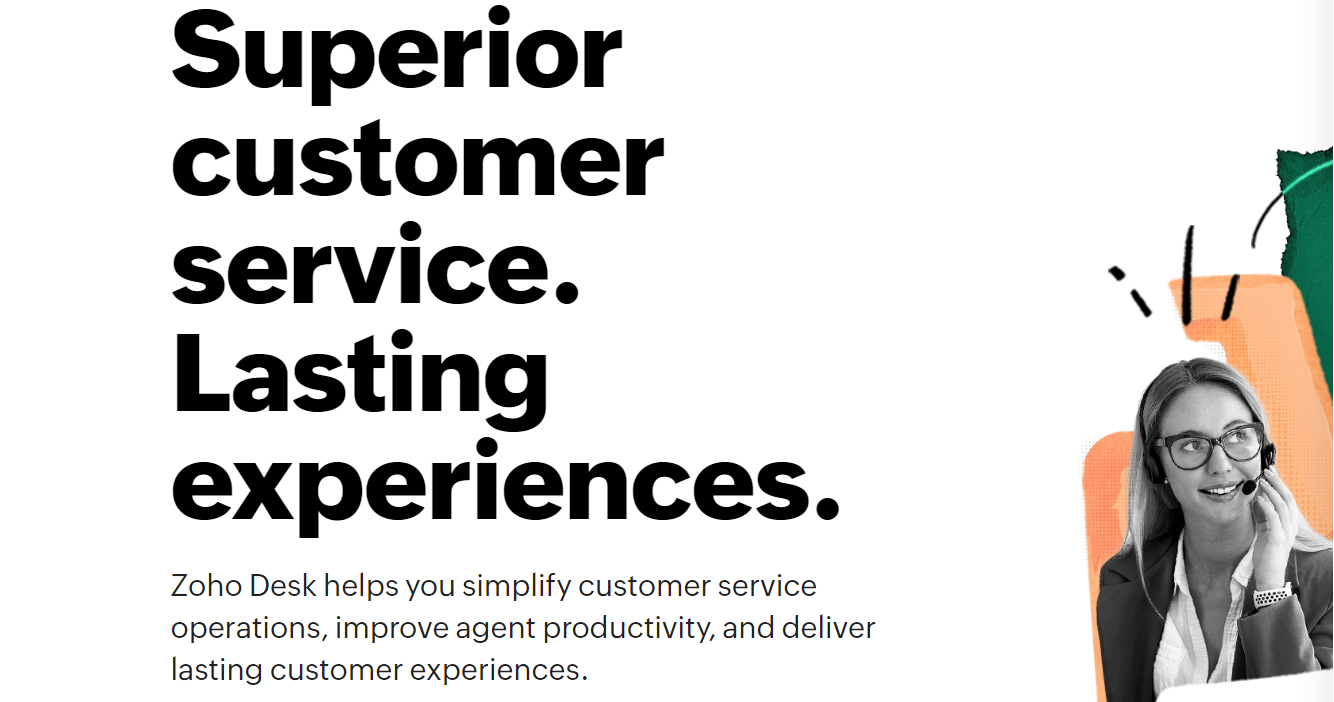
Zoho Desk is a customer service platform designed to elevate customer support experiences. It allows businesses to engage with customers seamlessly. It unifies support channels, streamlining issue resolution and fostering meaningful connections. With a focus on accessibility and customization, Zoho Desk ensures responsive and personalized customer interactions.
Best for: Issue resolution.
Key features:
- Live chat: Enables real-time communication for immediate support.
- Social media integration: Connects with social media platforms for customer engagement.
- Customer self-service: Empowers customers to find solutions independently.
- Community forums: Facilitates customer interaction and peer support.
- Multi-channel support: Integrates various communication channels for customer interactions.
Pros:
- Manages and tracks customer support queries through a centralized system.
- Includes a repository for customer information.
- Offers flexibility to customize features according to business needs.
- Intuitive design for easy navigation.
Cons:
- Advanced reporting features are limited in basic plans.
- Some users have complained about the responsiveness of customer support.
Pricing: Zoho Desk pricing page.
LiveAgent

LiveAgent is an all-in-one customer support platform. Designed for efficiency and simplicity, it consolidates communication channels into a unified solution. It empowers businesses to provide seamless, multi-channel customer support, fostering meaningful interactions. With a focus on accessibility, LiveAgent ensures businesses deliver exceptional customer service across diverse platforms.
Best for: Call centers.
Key features:
- Call center software: Facilitates voice communication for customer support.
- Live chat: Enables real-time communication for immediate support.
- Knowledge base: Provides a self-service repository for customer information.
- Automation: Streamlines workflows through automated processes.
- Social media integration: Connects with social media platforms for customer engagement.
Pros:
- Offers insights into support team performance.
- Tracks customer support queries through a centralized system.
- Works well for call centers.
- It is a great solution for small businesses.
Cons:
- Mobile app functionalities are limited compared to the desktop version.
- Some users find limitations in the ticketing system features.
Pricing: LiveAgent pricing page.
Freshdesk

Freshdesk is a customer support software that simplifies interactions between businesses and their customers. Recognized for its user-friendly interface and flexibility, Freshdesk consolidates customer queries across various channels into a unified platform. With a focus on efficiency and accessibility, Freshdesk empowers businesses to deliver seamless and personalized customer support experiences.
Best for: Comprehensive customer communication.
Key features:
- Social media integration: Connects with social media platforms for customer engagement.
- Customer self-service: Empowers customers to find solutions independently.
- Mobile accessibility: Allows support agents to manage tasks on the go through mobile apps.
- Reporting and analytics: Offers insights into support team performance.
- Integration capabilities: Seamlessly integrates with other business tools and applications.
Pros:
- Streamlines workflows by automating processes.
- Integrates various communication channels for customer interactions.
- Manages and tracks customer support queries through a centralized system.
Cons:
- Has fewer third-party apps compared to other platforms.
Pricing: FreshDesk pricing page.
Help Scout

Help Scout is a customer support platform designed to simplify interactions and foster meaningful connections. Renowned for its user-friendly design and collaborative approach, Help Scout transforms customer support into a seamless experience. With a focus on accessibility and personalization, it empowers businesses to provide exceptional customer service across various channels.
Best for: Customer support via email.
Key features:
- Shared inbox: Centralizes customer communication for efficient team collaboration.
- Collision detection: Prevents multiple team members from responding to the same customer query.
- Mailbox integration: Connects with various email providers for streamlined communication.
- Chat and messaging: Enables real-time communication with customers.
- Mobile accessibility: Allows support agents to manage tasks on the go through mobile apps.
Pros:
- Recurring tasks can be automated.
- Supports customer service via email.
- Makes it easy for team members to see which tickets have already been answered.
Cons:
- The social media integrations are limited compared to other tools.
Pricing: Help Scout pricing page.
Tidio

Tidio is a customer communication platform dedicated to enhancing online interactions. Tidio empowers businesses to engage with website visitors in real time. With a focus on user-friendly communication tools, Tidio facilitates seamless connections, enabling businesses to provide efficient and personalized customer support across various channels.
Best for: Chatbots.
Key features:
- Live chat: Facilitates real-time communication with website visitors.
- Chatbots: Uses AI-powered chatbots for automated interactions.
- Email marketing: Manages and automates email campaigns for customer engagement.
- Visitor tracking: Monitors and tracks website visitor behavior.
- Visitor tagging: Categorizes and tags website visitors for personalized interactions.
Pros:
- Handles email marketing campaigns.
- Offers customers multiple channels for support.
- Tags the types of visitors to your website.
- Provides chatbots.
Cons:
- Setting up complex email campaigns may require technical expertise.
Pricing: Tidio pricing page.
HappyFox

HappyFox is a customer support and helpdesk software designed to streamline and optimize customer interactions. Known for its user-friendly interface and automation capabilities, HappyFox simplifies ticketing, knowledge base management, and communication channels. With a focus on efficiency, it empowers businesses to deliver prompt and personalized customer service across various touchpoints.
Best for: Knowledge base management.
Key features:
- Knowledge base: Provides a self-service repository for customer information.
- Multi-channel support: Integrates various communication channels for customer interactions.
- Live chat: Facilitates real-time communication for immediate support.
- Mobile accessibility: Allows support agents to manage tasks on-the-go through mobile apps.
- Reporting and analytics: Offers insights into customer support team performance.
Pros:
- Organizes and tracks tasks related to customer support.
- Had lots of integration options.
- Empowers customers to find solutions independently.
Cons:
- Advanced reporting features are limited in basic plans.
Pricing: HappyFox pricing page.
Business analytics
Hotjar

Hotjar is a powerful analytics and feedback tool transforming how businesses understand user behavior. Known for its user-friendly design and actionable insights, Hotjar consolidates visual analytics, heatmaps, and user feedback. By providing a holistic view of website interactions, Hotjar enables businesses to make data-driven decisions and enhance the user experience effectively.
Best for: Heatmapping.
Key features:
- Heatmaps: Visualizes user interactions on web pages.
- Session recordings: Captures and replays user sessions for analysis.
- Surveys and feedback: Gathers user opinions and feedback.
- Conversion funnels: Tracks user journeys through conversion processes.
- Form analysis: Analyzes user behavior on web forms.
Pros:
- Offers visual insights through heatmaps and session recordings.
- Has cost-effective pricing plans for various business sizes.
- Facilitates user recruitment for usability testing.
- Provides valuable insights into user behavior and preferences.
Cons:
- Some features don’t provide real-time data.
- Users encounter occasional bugs or glitches.
Pricing: Hotjar pricing page.
Google Analytics

Google Analytics is a robust web analytics service offered by Google, giving businesses the ability to track and analyze website performance. Google Analytics provides a wealth of data on user behavior, traffic sources, and engagement metrics. Its user-friendly interface enables businesses to make informed decisions and optimize online experiences effectively.
Best for: Small businesses.
Key features:
- Audience reports: Analyzes user demographics, interests, and behavior.
- Acquisition reports: Tracks traffic sources and marketing channels.
- Behavior reports: Examines user interactions with site content.
- Conversions: Measures goal completions and e-commerce transactions.
- Real-time analytics: Monitors user activity on the site in real time.
Pros:
- Creates customized reports based on specific metrics.
- Measures user interactions with specific website elements.
- Tracks sales and user behavior in e-commerce sites.
- Sets and tracks specific user actions as goals.
Cons:
- Ad-blockers may affect data accuracy.
- It’s a complex tool for beginners and has a steep learning curve.
Pricing: Google Analytics is free!
Oracle

Oracle for business analytics is a robust solution offering a suite of tools for data analysis and reporting. Leveraging advanced analytics, data visualization, and machine learning, Oracle enables businesses to extract valuable insights from their data. With a focus on scalability and agility, it empowers organizations to make informed decisions and drive business intelligence effectively.
Best for: Using data insights to scale operations.
Key features:
- Advanced analytics: Utilizes advanced statistical and mathematical models for in-depth analysis.
- Comprehensive data integration: Integrates data from various sources for a comprehensive view.
- Data visualization: Provides visual representation of data for easier interpretation.
- Machine learning capabilities: Incorporates machine learning algorithms for predictive analysis.
- Scalability: Scales to handle large datasets and growing business needs.
Pros:
- Creates reports and dashboards tailored to specific business needs.
- Enables users to perform analytics without extensive technical expertise.
- Utilizes cloud infrastructure for flexibility and accessibility.
- Implements robust security measures to ensure data protection and compliance.
Cons:
- Implementation and licensing costs may be relatively high.
- Requires substantial computing resources for optimal performance.
Pricing: Oracle pricing page.
SAS

SAS, a leader in analytics software, empowers organizations through innovative solutions in data analytics and business intelligence. Renowned for its advanced analytics tools and scalable platforms, SAS offers comprehensive solutions that enable data-driven decision-making, fostering growth and transformation across industries worldwide.
Best for: Business intelligence.
Key features:
- Text analytics: Analyzes unstructured text data for insights.
- Business intelligence: Delivers insights through dashboards and reports.
- Risk management: Offers tools for risk assessment and mitigation.
- Fraud detection: Detects anomalies and potential fraudulent activities.
- Decision optimization: Optimizes decision-making processes using analytics.
Pros:
- Utilizes advanced statistical methods and machine learning algorithms.
- Efficiently handles large and complex datasets.
- Provides highly accurate and reliable results.
- Implements strong security measures for data protection.
Cons:
- Dependency on SAS ecosystem might limit flexibility.
- Licensing structure might be complex and restrictive for some users.
Pricing: SAS pricing page.
Looker

Looker Studio, now part of Google Cloud, offers a modern data analytics platform. Looker enables businesses to explore and derive insights from their data effortlessly. With a focus on user-friendly analytics, it empowers data-driven decision-making across organizations of all sizes.
Best for: Simplifying analytics.
Key features:
- Intuitive interface: User-friendly interface for easy data exploration and analysis.
- Customizable dashboards: Enables creation of interactive and customizable dashboards.
- Data visualization: Offers visually appealing and comprehensive data representation.
- Advanced analytics: Utilizes advanced statistical and analytical functions.
- Collaboration tools: Encourages collaboration through data sharing and annotations.
Pros:
- Allows embedding analytics into other applications.
- Facilitates integration and extensibility through APIs.
- Generates detailed and insightful reports.
- Now part of Google Cloud, enhancing integration capabilities.
Cons:
- Setting up and configuring the platform may require technical expertise.
- Requires significant resources for optimal performance.
Pricing: Looker Studio pricing page.
Qlik
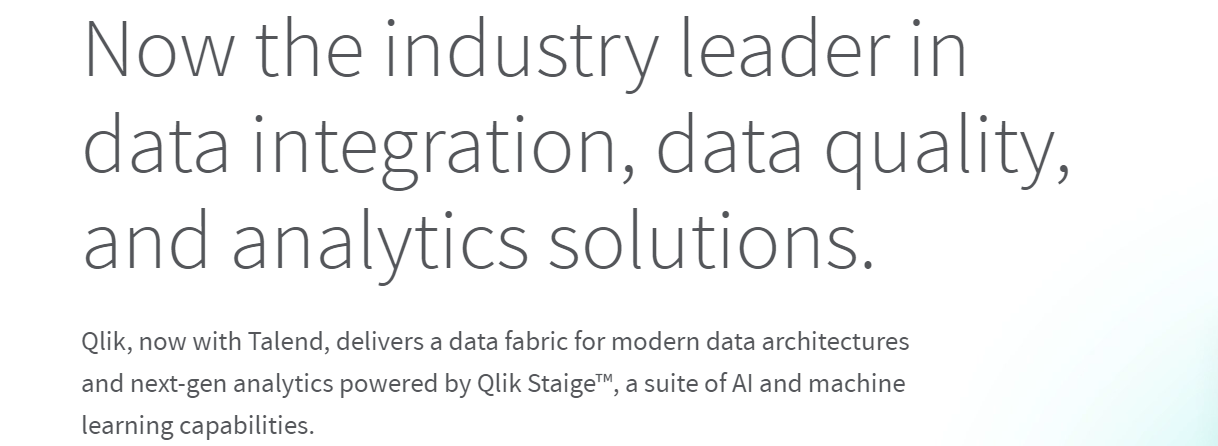
Qlik, a leading analytics platform, revolutionizes data discovery and analytics. It offers real-time insights by exploring relationships within data. Its user-centric approach gives users the ability to to make informed decisions swiftly, fostering a data-driven culture that drives innovation and business success.
Best for: Predictive analytics.
Key features:
- Associative engine: Explores relationships and associations within data for dynamic analysis.
- Data integration: Aggregates and integrates data from multiple sources for unified analysis.
- Self-service analytics: Enables users to create their own queries and reports without IT support.
- Predictive analytics: Utilizes predictive modeling for future trend analysis.
- Advanced calculations: Performs complex calculations and statistical functions.
Pros:
- Creates interactive and visually rich dashboards and reports.
- Active user community and resources are available for assistance.
- Facilitates collaboration through shared analytics and data.
- Scales to handle large datasets and evolving business needs.
Cons:
- Mobile access has limited functionalities.
- Pricing is fairly high.
Pricing: Qlik pricing page.
Domo

Domo is a cloud-based business intelligence platform that handles data management and visualization. It gives organizations the power to harness and leverage their data efficiently. Its user-friendly approach and extensive capabilities drive data-driven decision-making across diverse industries, fostering innovation and growth.
Best for: Data management.
Key features:
- Alerts and notifications: Sends alerts based on predefined conditions in the data.
- Data security: Implements robust security measures for data protection.
- Customizable reports: Generates customizable reports tailored to business needs.
- Data visualization: Creates interactive and visually appealing dashboards.
- Business intelligence: Offers comprehensive business intelligence tools.
Pros:
- Aggregates and integrates data from multiple sources.
- Provides insights into data in real time.
- Accesses analytics and insights on mobile devices.
Cons:
- Quality of support might vary based on the subscription plan.
Pricing: Domo pricing page.
Spotfire

Spotfire is an advanced analytics platform that empowers organizations with intuitive data analysis and visualization. Renowned for its user-friendly interface and predictive analytics, Spotfire drives data-driven decision-making. It facilitates innovation through robust capabilities and real-time insights, enabling businesses to extract valuable insights and excel in today’s competitive landscape.
Best for: Intuitive data visualization.
Key features:
- Real-time analytics: Provides insights into data in real time.
- Predictive analytics: Utilizes predictive modeling for future trend analysis.
- Alerts and notifications: Sends alerts based on predefined conditions in the data.
- Data security: Implements robust security measures for data protection.
- Customizable reports: Generates customizable reports tailored to business needs.
Pros:
- Integrates data from multiple sources.
- Offers comprehensive business intelligence tools.
- Facilitates collaboration through shared data and insights.
Cons:
- Pricing information isn’t available on the website.
Pricing: Spotfire sales page.
Accounting
QuickBooks

QuickBooks, developed by Intuit, is a leading accounting software catering to businesses of all sizes. It streamlines financial tasks like invoicing, expense tracking, and tax preparation. With its comprehensive tools, QuickBooks simplifies accounting processes, enabling better financial management and decision-making.
Best for: Overall accounting.
Key features:
- Invoicing: Creates and sends professional invoices to clients.
- Expense tracking: Monitors and categorizes business expenses.
- Financial reporting: Generates comprehensive financial reports.
- Tax preparation: Helps prepare and organize tax-related information.
- Bank reconciliation: Matches transactions with bank records for accuracy.
Pros:
- Handles payroll tasks, including salary and taxes.
- Helps with expense management.
- Manages billing and tracks payments.
- Tracks billable hours for projects or clients.
Cons:
- Some advanced features lack customization options.
- Some users express concerns about data security in the cloud-based version.
Pricing: QuickBooks pricing page.
OneUp

OneUp simplifies business management with its intuitive cloud-based accounting software. Offering seamless invoicing, expense tracking, and inventory management, it streamlines operations for small businesses. With its user-friendly interface and comprehensive tools, OneUp facilitates efficient financial management, empowering businesses to thrive and grow
Best for: Inventory management.
Key features:
- Financial reporting: Generates comprehensive financial reports for financial health.
- Billing and payments: Manages billing processes and tracks payments.
- Tax preparation: Helps organize tax-related information for filing.
- Budgeting and forecasting: Assists in planning and projecting financial data.
- Multi-currency support: Handles transactions in various currencies.
Pros:
- Efficiently tracks and categorizes business expenses.
- Simplifies invoicing processes for businesses.
- Offers accessibility from anywhere with the internet.
- Intuitive interface suitable for non-accountants.
Cons:
- Users have reported poor and inconsistent customer support.
- Speed and performance sometimes slows down with extensive data.
Pricing: Contact the OneUp sales team for pricing.
ZipBooks

ZipBooks is accounting software designed for small businesses. Known for its simplicity, it streamlines invoicing, expense tracking, and financial reporting. With a focus on ease of use and affordability, ZipBooks empowers entrepreneurs to manage finances efficiently, providing essential tools for streamlined financial management and growth.
Best for: Invoicing.
Key features:
- Invoicing: Creates and sends professional invoices to clients.
- Expense tracking: Monitors and categorizes business expenses.
- Financial reporting: Generates comprehensive financial reports.
- Budgeting and forecasting: Assists in planning and projecting financial data.
- Customer management: Organizes and manages customer information.
Pros:
- Helps organize tax-related information for filing.
- Offers a free plan.
- Tracks billable hours for projects or clients.
- Automates the invoicing process.
Cons:
- Integration options with third-party apps are limited.
- May not be as suitable for larger businesses with complex needs.
Pricing: ZipBooks pricing page.
Kashoo

Kashoo is a user-friendly accounting software that simplifies financial management for small businesses. Known for its intuitive interface and accessibility, Kashoo streamlines invoicing, expense tracking, and reporting. With a focus on simplicity and affordability, it empowers entrepreneurs to efficiently manage finances and financial health, fostering growth and financial stability.
Best for: Small businesses.
Key features:
- Receipt capture: Allows users to capture and store receipts digitally.
- Invoicing: Creates and sends professional invoices to clients.
- Expense tracking: Monitors and categorizes business expenses.
- Bank reconciliation: Matches transactions with bank records for accuracy.
- Multi-currency support: Handles transactions in various currencies.
Pros:
- Stores data securely in the cloud for easy access and backup.
- Designed for small businesses.
- Provides access to accounting tools on mobile devices.
Cons:
- Certain advanced features require an upgrade to a higher-priced plan.
Pricing: Kashoo pricing page.
Xero

Xero is a leading accounting software that streamlines invoicing, expense tracking, and reporting. With cloud-based accessibility and a focus on user-centric design, it empowers businesses to efficiently manage finances, fostering growth and success.
Best for: Online payment.
Key features:
- Online payments: Accepts online payments through various gateways.
- Payroll management: Handles payroll tasks, including taxes and deductions.
- Inventory management: Tracks and manages inventory levels.
- Multi-currency support: Handles transactions in various currencies.
- Tax preparation: Helps organize tax-related information for filing.
Pros:
- Creates and sends professional invoices to clients.
- Matches transactions with bank records for accuracy.
- Helps with expense management.
- Tracks project profitability.
Cons:
- Not as suitable for larger businesses with complex needs.
- Additional features or add-ons may increase overall costs for users.
Pricing: Xero pricing page.
NetSuite ERP

NetSuite ERP is a comprehensive cloud-based enterprise resource planning system. Renowned for its integrated functionalities, it manages core business operations like financials, inventory, procurement, and more. With scalability and customization, NetSuite ERP empowers businesses to streamline processes, optimize operations, and drive growth in a unified platform.
Best for: E-commerce.
Key features:
- E-commerce: Enables integrated online commerce functionalities.
- Supply chain management: Enhances visibility and efficiency in the supply chain.
- Financial management: Streamlines accounting processes, billing, and revenue recognition.
- Order management: Automates order-to-cash and procurement processes.
- Inventory management: Optimizes inventory levels and supply chain operations.
Pros:
- Offers a wide range of integrated business functionalities.
- Supports global operations with multi-language and multi-currency features.
- Scales to accommodate business growth and changing needs.
- Offers robust support services and training resources.
Cons:
- There is no pricing information available on the website.
- Initial setup and implementation can be time-consuming and complex.
Pricing: NetSuite ERP sales page.
Rossum

Rossum is an AI-driven document processing platform that manages data extraction and processing. Renowned for its machine learning capabilities, Rossum automates data capture from documents. With its accuracy and efficiency, it transforms tedious manual tasks into seamless processes, empowering businesses to handle documents effortlessly and boost productivity.
Best for: Document processing.
Key features:
- AI-powered data extraction: Utilizes AI to extract data accurately from various documents.
- Document processing automation: Automates document data capture and processing workflows.
- Machine learning capabilities: Improves accuracy over time through machine learning algorithms.
- Data security: Ensures data security and compliance through robust measures.
- Vendor invoice management: Specializes in vendor invoice processing and management.
Pros:
- Integrates with various systems and software for seamless operation.
- Tailors workflows to specific document types and business needs.
- Automates documentation processes.
Cons:
- Relies on AI accuracy, which might require occasional human verification.
Pricing: Rossum pricing request.
Trolley

Trolley is a payout software solution facilitating streamlined and secure payment distribution. With a focus on simplicity, it offers automated payment processing for businesses, ensuring swift and accurate payouts to employees, vendors, or partners. Trolley optimizes financial workflows, enhancing efficiency and reliability in fund distribution processes.
Best for: International payouts.
Key features:
- Payout automation: Automates payout process workflows.
- IRS tax compliance: Follows all IRS regulations for e-filing.
- Internationally recognized: Payouts can be made in over 200 countries and territories.
- EU tax compliance: Offers end-to-end DAC7 compliance for all EU vendors.
- Identity verification: Allows organizations to set up identity verification for clients.
Pros:
- It has extensive payout options.
- APIs are extremely easy to use.
- Very friendly and helpful customer support.
- Automations are very quick and easy to set up.
Cons:
- Payment status can be difficult to track.
Pricing: Trolley pricing page.
Marketing
SEMrush

SEMrush, a versatile digital marketing tool, empowers businesses with comprehensive insights and strategies. Renowned for its robust analytics, SEMrush offers SEO, advertising, content, and social media solutions. It helps businesses optimize their online presence, drive traffic, and maximize conversions.
Best for: Overall digital marketing.
Key features:
- Keyword research: Identifies profitable keywords for SEO and PPC campaigns.
- Competitive analysis: Analyzes competitors’ strategies across various digital channels.
- Site audit: Scans websites for SEO issues and optimization opportunities.
- Backlink analysis: Assesses backlink profiles and identifies linking opportunities.
- Content marketing toolkit: Assists in content creation and optimization.
Pros:
- Helps optimize paid advertising campaigns.
- Monitors and analyzes social media performance.
- Monitors keyword rankings and performance.
- Provides insights into specific industry trends and data.
Cons:
- Higher pricing tiers might be a barrier for small businesses or individuals.
- Local SEO data might not cover all regions comprehensively.
Pricing: SEMrush pricing page.
Canva

Canva is a graphic design tool offering a platform for creating visuals. Renowned for its simplicity, Canva provides tools for designing graphics, presentations, and marketing materials. With its extensive library and intuitive interface, it empowers users to craft professional-quality visuals effortlessly, regardless of design expertise.
Best for: Graphic design.
Key features:
- Image library: Extensive collection of stock photos, icons, and illustrations.
- Brand kit: Stores brand assets for consistent branding.
- Social media integration: Direct sharing to social media platforms.
- Animations: Allows creation of animated graphics and presentations.
- Print and digital designs: Supports designs for both online and print media.
Pros:
- Offers various design templates for different purposes.
- Allows easy editing of elements, colors, and fonts.
- Supports sharing and teamwork on design projects.
- Provides basic features at no cost.
Cons:
- Some templates lack customization options.
- There are limitations in the number of brand assets in the free version.
Pricing: Canva pricing page.
Ahrefs

Ahrefs is a robust SEO tool giving businesses comprehensive insights and analysis. Renowned for its depth of data and accuracy, Ahrefs offers solutions for backlink analysis, keyword research, site audits, and competitive analysis. Its intuitive interface aids in optimizing online strategies, boosting site traffic, and improving search rankings.
Best for: SEO.
Key features:
- Site explorer: Analyzes backlinks and organic search traffic of any website.
- Keywords explorer: Researches keywords for SEO and PPC campaigns.
- Content explorer: Helps in content research and topic ideation.
- Rank tracker: Monitors keyword rankings in search engines.
- Backlink checker: Analyzes backlink profiles and domains.
Pros:
- Identifies and fixes on-site SEO issues.
- Notifies about new and lost backlinks, keyword rankings, etc.
- Compares multiple websites’ SEO metrics.
- Assists in analyzing and optimizing paid search campaigns.
Cons:
- Advanced customization might be complex for some users.
- Competitive data might not always be entirely accurate.
Pricing: Ahrefs pricing page.
HubSpot

HubSpot revolutionizes marketing strategies, focusing on inbound methodologies. Renowned for its intuitive tools, it empowers businesses to attract, engage, and delight customers effectively. From lead generation to analytics, HubSpot Marketing facilitates seamless campaigns, personalized interactions, and data-driven decisions, optimizing marketing endeavors for sustainable growth.
Best for: Inbound marketing.
Key features:
- Email marketing: Templates, sequences, and analytics for email campaigns.
- Lead capture: Forms, pop-ups, and CTAs to capture and convert leads.
- SEO tools: Optimization suggestions and keyword tracking.
- CRM integration: Alignment with the CRM for lead nurturing.
- A/B testing: Testing variations for better campaign performance.
Pros:
- Offers reliable support resources and assistance.
- Integrates various marketing tools in one platform.
- Has blogging and content creation capabilities.
- Offers comprehensive insights for performance measurement.
Cons:
- Users have reported data privacy concerns in some modules or features.
- Advanced CRM features require higher-tier subscriptions.
Pricing: Hubspot pricing page.
AdRoll

AdRoll, a comprehensive advertising platform, specializes in retargeting and prospecting solutions. Renowned for its cross-channel capabilities, AdRoll optimizes ad campaigns across web, social media, and email. With robust targeting and analytics, it empowers businesses to reach and convert audiences effectively, boosting brand visibility and conversions.
Best for: Advertising.
Key features:
- Retargeting: Targets users who have interacted with the brand previously.
- Prospecting: Reaches new audiences similar to existing customers.
- Cross-channel advertising: Runs ads across web, social media, and email.
- Dynamic ads: Personalizes ad content based on user behavior.
- Audience segmentation: Divides audiences for tailored targeting.
Pros:
- Tracks ad performance and ROI.
- Allows easy creation and customization of ads.
- Optimizes campaigns for better results.
- Integrates with various platforms and e-commerce systems.
Cons:
- May be overwhelming for beginners due to its extensive features.
- There are limited features in the pay-as-you-go option.
Pricing: AdRoll pricing page.
Adobe Express

Adobe Express simplifies graphic design for social media and marketing. With an intuitive interface, it offers easy creation of visuals, including posts, flyers, and banners. Adobe Express ensures professional-looking designs without prior design experience, empowering users to craft stunning visuals effortlessly.
Best for: TikTok ads.
Key features:
- Spark Post: Creates social media graphics, posters, and banners.
- Spark Page: Builds web pages and stories with visual narratives.
- Spark Video: Produces videos using templates and customizable themes.
- Templates and themes: Extensive library for various design needs.
- Brand customization: Allows brand elements to be integrated into designs.
Pros:
- Enables teamwork and sharing within projects.
- Provides resources and inspiration for design ideas.
- Connects with Creative Cloud and other Adobe tools.
- Offers diverse options for creating graphics, web pages, and videos.
Cons:
- There are limits in storage for designs or projects.
- There are limited file format options for exporting designs.
Pricing: Adobe Express pricing page.
Wistia
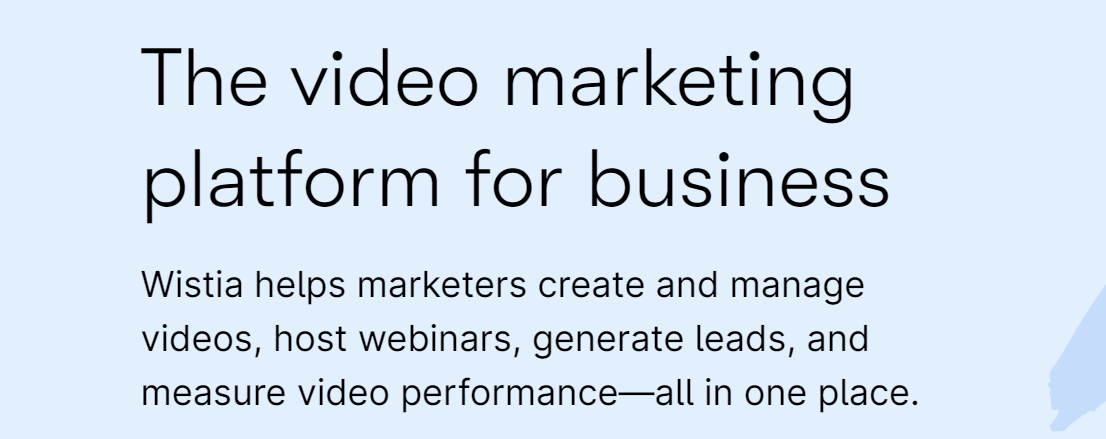
Wistia, a video hosting platform, stands out for its business-oriented video solutions. Renowned for its customizable player and analytics, Wistia caters to marketing and sales needs, offering tools for video creation, hosting, and analytics. With emphasis on brand control and audience engagement, it enhances video marketing strategies effectively.
Best for: Video hosting.
Key features:
- Video hosting: Secure and reliable hosting for business videos.
- Customizable video player: Allows customization to align with brand aesthetics.
- Video creation tools: Editing and creation capabilities within the platform.
- Interactive video elements: Adds clickable elements and calls-to-action.
- Video SEO: Optimizes videos for search engine visibility.
Pros:
- Tracks video performance and viewer engagement.
- Ensures videos display correctly on different devices.
- Offers privacy options and security measures for videos.
- Connects with marketing automation and CRM tools.
Cons:
- Some advanced editing features are lacking compared to other editing tools.
- The UI can be a little complicated for new users.
Pricing: Wistia pricing page.
Eventbrite

Eventbrite is a versatile event management platform that streamlines event planning and ticketing. Renowned for its user-friendly interface, it empowers organizers to create, promote, and manage events effortlessly. With robust ticketing solutions and promotion tools, Eventbrite caters to events of all scales, fostering seamless event experiences for organizers and attendees alike.
Best for: Event planning.
Key features:
- Event creation: Easily create and customize event pages.
- Ticketing: Offers various ticket types and pricing options.
- Promotion tools: Marketing and promotional features for events.
- Registration management: Tracks registrations and attendee information.
- Payment processing: Secure and integrated payment processing.
Pros:
- Offers email and messaging tools for attendees.
- Gives insights and reporting on event performance.
- Integrates with other tools and platforms.
- Has seating and capacity management options.
Cons:
- Eventbrite retains some control over attendee data.
- Charges service fees per ticket sold, affecting overall costs.
Pricing: Eventbrite pricing plan.
Sales
Salesforce

Salesforce is a leading CRM platform that gives businesses cloud-based solutions for sales, marketing, and service. Renowned for its scalability and customization, Salesforce streamlines customer interactions, data management, and automation. It revolutionizes business processes, fostering robust customer relationships and driving organizational growth through innovative cloud technology.
Best for: CRM.
Key features:
- Sales Cloud: CRM tools for sales automation and lead management.
- Service Cloud: Customer service and support functionalities.
- Commerce Cloud: E-commerce and customer experience management.
- Community Cloud: Engages customers and partners with communities.
- Analytics Cloud: Data analysis and visualization tools.
Pros:
- Offers a wide range of CRM solutions for diverse business needs.
- Scales with business growth and requirements effectively.
- Has robust security measures and data protection features.
- Extensive AppExchange for additional functionalities.
Cons:
- Requires dedicated resources for setup and maintenance.
- Mastery of advanced features might take time and training.
Pricing: Salesforce pricing page.
Pipedrive

Pipedrive is a CRM that specializes in sales pipeline management. It aids sales teams in tracking deals and managing contacts efficiently. With its visual interface and customizable workflow, Pipedrive streamlines sales processes, fostering a clear and organized approach to driving successful deals.
Best for: Sales pipeline management.
Key features:
- Sales pipeline management: Visual and customizable pipeline for deals.
- Contact management: Organizes and manages customer and prospect contacts.
- Deal tracking: Tracks deals through stages for sales progress.
- Activity scheduler: Plans and schedules sales-related activities.
- Email integration: Syncs emails and tracks communication within deals.
Pros:
- Automates repetitive tasks and workflows.
- Provides visual representation for clear deal tracking.
- Provides insights into sales performance with reporting and analytics.
- Connects with various apps and tools for enhanced functionality.
Cons:
- It has limits in storage that might affect certain plans or usage.
- The platform has occasional service outages.
Pricing: Pipedrive pricing page.
Gong
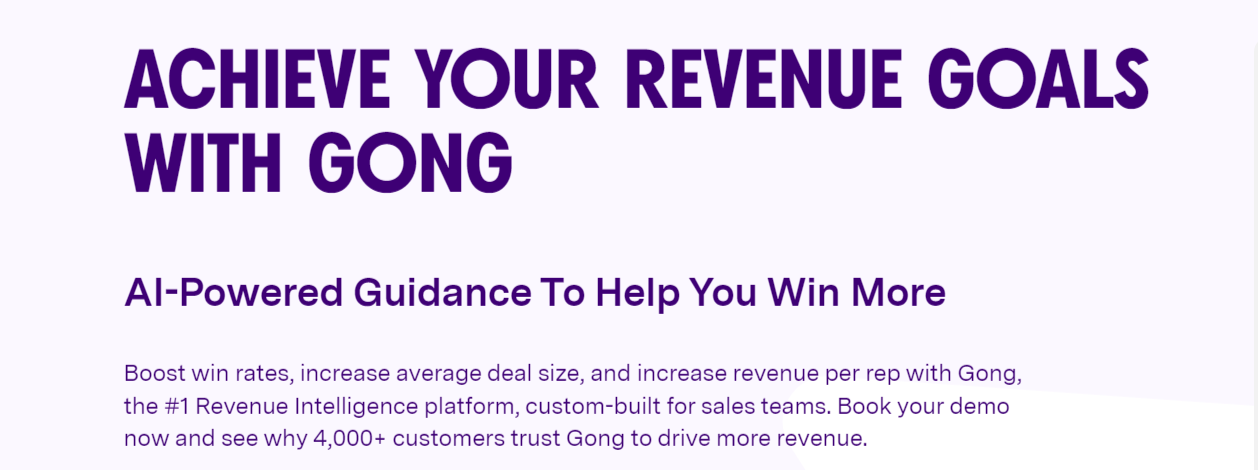
Gong, an AI-powered revenue intelligence platform, assists sales teams by recording, transcribing, and analyzing sales calls. Through insights derived from these interactions, Gong identifies patterns, provides coaching opportunities, and enhances sales strategies, enabling teams to refine pitches, understand customer needs, and ultimately close more deals effectively.
Best for: Sales calls.
Key features:
- Call recording: Records and stores sales calls for analysis.
- Transcription: Converts sales calls into text for review and search.
- AI-powered insights: Analyzes calls to provide actionable insights.
- Conversation analytics: Identifies trends and patterns in sales conversations.
- Coaching tools: Provides coaching opportunities based on call analysis.
Pros:
- Offers visibility into the status of deals and opportunities.
- Syncs with CRM systems for streamlined data.
- Allows real-time monitoring of sales conversations.
- Tracks and measures sales team performance.
Cons:
- The pricing is higher compared to some other sales intelligence platforms.
- Raises concerns regarding call recording and privacy.
Pricing: Gong pricing page.
Demandbase

Demandbase aids sales by aligning marketing efforts with specific accounts. Its AI-powered tools provide deep insights, enabling sales teams to understand buyer behavior and preferences better. With personalized and targeted approaches, it facilitates more effective outreach, nurturing stronger relationships, and increasing the likelihood of successful sales conversions.
Best for: B2B outreach.
Key features:
- Account identification: Identifies and prioritizes target accounts.
- AI-powered insights: Provides data-driven insights for better targeting.
- Intent monitoring: Tracks online behavior to gauge purchase intent.
- Sales intelligence: Offers insights to aid sales teams in targeting accounts.
- Lead scoring: Ranks leads based on their likelihood to convert.
Pros:
- Identifies and prioritizes high-value target accounts.
- Integrates with CRM systems for streamlined data.
- Measures and analyzes account-based marketing performance.
- Enables real-time engagement with target accounts.
Cons:
- Limits in data storage might impact certain plans.
- Some users report limitations in customer support.
Pricing: Demandbase pricing page.
LeadSquared

LeadSquared is a comprehensive CRM and marketing automation platform catering to sales and marketing needs. Renowned for its lead management and engagement tools, it streamlines customer journeys and nurtures leads effectively. With robust automation, analytics, and sales acceleration features, LeadSquared facilitates better customer engagement and conversion optimization.
Best for: Lead management.
Key features:
- Lead management: Tracks and manages leads through the sales funnel.
- Marketing automation: Automates marketing campaigns and workflows.
- CRM integration: Integrates with CRM systems for streamlined data.
- Sales automation: Automates sales processes for efficiency.
- Workflow automation: Sets up automated workflows for various processes.
Pros:
- Offers a wide range of CRM and marketing automation tools.
- Ranks leads to prioritize high-potential prospects.
- Assigns and tracks tasks for streamlined workflows.
- Provides insights into marketing and sales performance.
Cons:
- Pricing might be a constraint for smaller businesses or startups.
- Integration might be challenging with certain systems.
Pricing: LeadSquared pricing page.
BIGContacts

BIGContacts is a user-friendly CRM designed for small businesses. It streamlines contact management, offering a centralized hub for customer data. Renowned for its simplicity, it provides tools for managing contacts, calendars, and tasks, fostering efficient communication and organization within smaller business environments.
Best for: Small business contact management.
Key features:
- Contact management: Organizes and manages customer and prospect contacts.
- Calendar integration: Syncs calendars for scheduling and appointmen
- Sales pipeline management: Tracks and manages sales opportunities.
- Document storage: Stores and manages documents related to contacts.
- Lead tracking: Monitors and tracks leads through the sales process.
Pros:
- Super budget friendly for small businesses.
- Manages email communication within the CRM.
- Allows customization to capture specific data.
- Provides customer support and resources for users.
Cons:
- Lacks some advanced functionalities compared to larger CRMs.
- Advanced analytics and reporting might be basic.
Pricing: BIGContacts pricing page.
Seismic

Seismic is a sales enablement platform that arms sales teams with personalized content and intelligence. Renowned for its automation and personalization capabilities, it offers content management, sales readiness, and analytics tools. By aligning sales and marketing, Seismic enhances productivity, streamlines content delivery, and drives revenue growth efficiently.
Best for: Sales enablement.
Key features:
- Content management: Organizes and manages marketing and sales content.
- Sales enablement: Empowers sales teams with personalized content.
- Content automation: Automates content delivery based on sales needs.
- Sales readiness: Prepares sales teams with training and resources.
- Document assembly: Builds personalized documents for sales engagements.
Pros:
- Provides insights into content performance.
- Automates content delivery based on sales needs.
- Allows access and delivery of content on mobile devices.
Cons:
- Some users report limitations in customer support.
Pricing: Seismic pricing information only available with a demo.
LeadIQ

LeadIQ is a prospecting tool simplifying lead generation for sales professionals. Renowned for its ease of use, it streamlines the process of finding, enriching, and managing leads. With its intuitive interface and time-saving capabilities, LeadIQ facilitates efficient lead sourcing, enabling focused and targeted sales outreach strategies.
Best for: B2B prospecting.
Key features:
- Lead capture: Extracts and captures leads from various sources.
- Prospect enrichment: Augments lead data with additional information.
- CRM integration: Syncs seamlessly with CRM platforms for data transfer.
- Lead scoring: Ranks leads based on their potential conversion likelihood.
- Prospecting lists: Creates and manages prospecting lists for outreach.
Pros:
- Automates sales processes for increased efficiency.
- Designed for B2B sales.
- Offers insights into prospecting performance.
- Enables collaboration among team members on leads.
Cons:
- May face limitations in scaling for larger operations.
- Advanced customization options can be limited.
Pricing: LeadIQ pricing page.
Email management
Mailchimp

Mailchimp is a widely-used email marketing platform known for its user-friendly interface and marketing automation capabilities. It empowers businesses with email campaign management, audience segmentation, email lists, and analytics. Renowned for its versatility, Mailchimp enables effective communication, engagement, and nurturing of customer relationships through targeted marketing efforts.
Best for: Email marketing.
Key features:
- Email marketing: Creation, scheduling, and sending of marketing emails.
- Audience management: Segmentation and organization of subscriber lists.
- Templates: Pre-designed templates for email campaigns.
- Landing pages: Creation of customized landing pages for campaigns.
- A/B testing: Testing variations of campaigns for optimization.
Pros:
- Automates email campaigns for targeted outreach.
- Provides insights into campaign performance and audience engagement.
- Allows audience segmentation for personalized campaigns.
- Offers a free plan with basic features for small businesses.
Cons:
- Has stricter policies on certain content for delivery.
- Integration complexities with certain CRM systems.
Pricing: Mailchimp pricing page.
Hiver
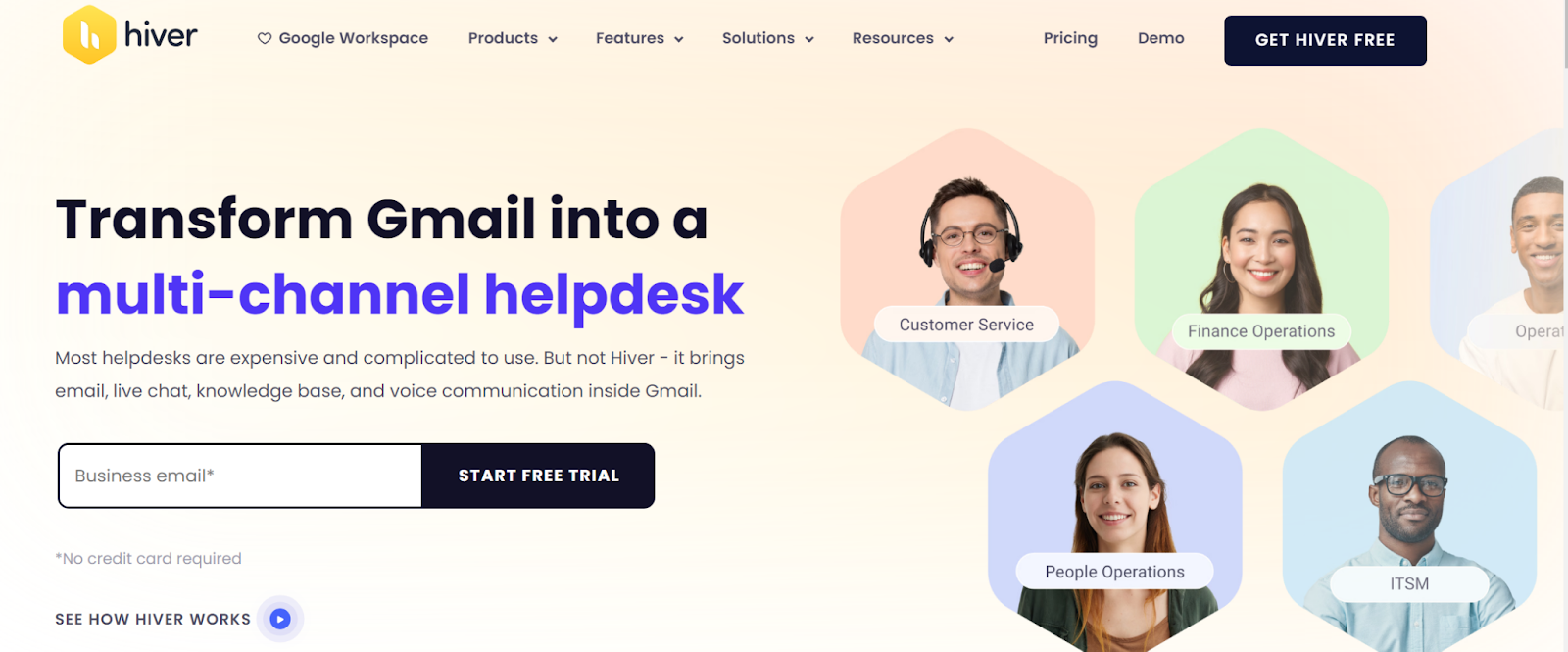
Hiver simplifies email management by turning Gmail into a shared inbox. It enables teams to collaborate efficiently on shared emails, assign tasks, and track emails without leaving Gmail. Hiver streamlines communication, enhances teamwork, and boosts productivity within the familiar Gmail interface.
Best for: Gmail management.
Key features:
- Shared inbox: Converts Gmail into a shared team inbox.
- Email assigning: Assigns emails to team members for follow-up.
- Email notes: Adds internal notes to emails for team collaboration.
- Email templates: Saves and uses email templates for quick responses.
- Collision alerts: Alerts when multiple team members respond to the same email.
Pros:
- Tags emails for easy organization and categorization.
- Temporarily hides emails and sets reminders for later.
- Provides insights into team email performance.
- Creates and manages tasks directly from emails.
Cons:
- Heavy usage might slow down Gmail performance.
- There are limits to data storage.
Pricing: Hiver pricing page.
SaneBox
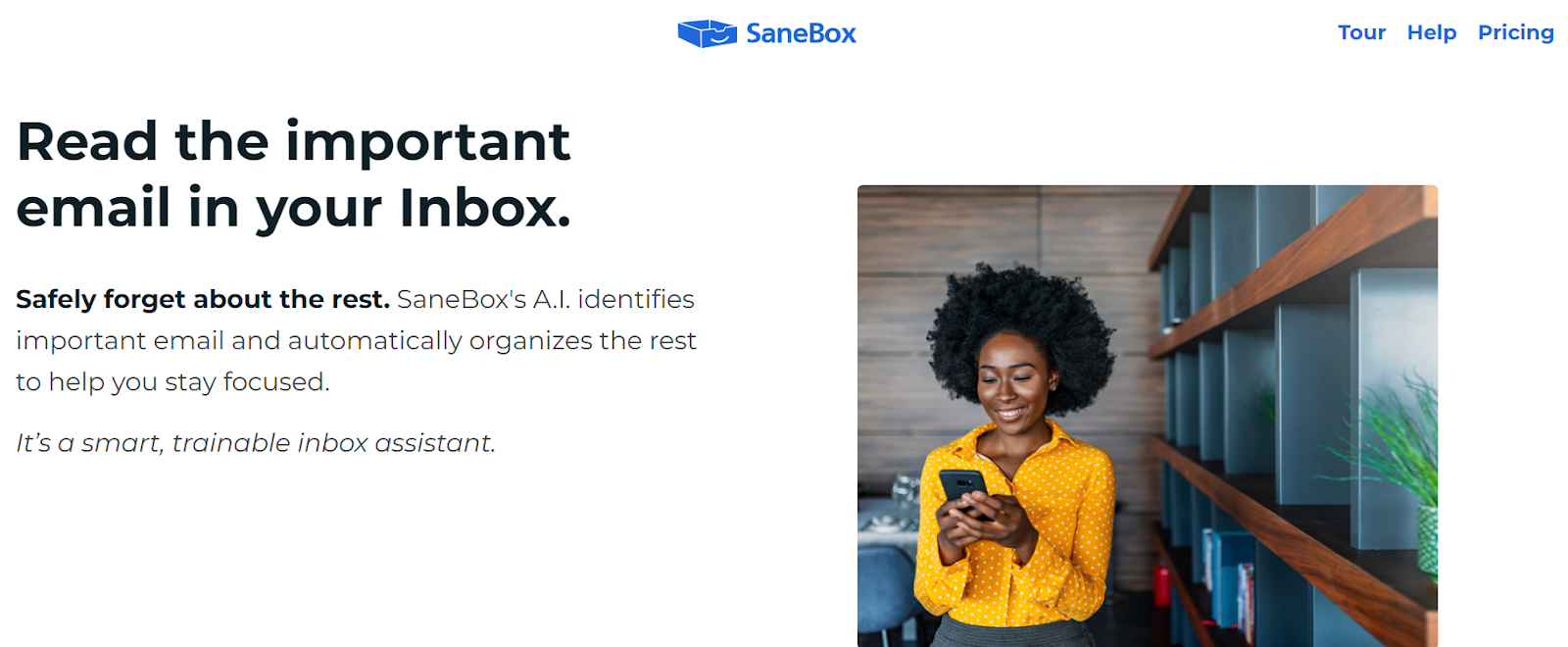
SaneBox is an email management tool that prioritizes important emails and declutters your inbox by organizing and filtering messages. Renowned for its efficiency, it automates email organization, categorizes messages, and ensures crucial emails receive prompt attention, allowing users to focus on essential communication within a streamlined inbox experience.
Best for: Decluttering the inbox.
Key features:
- Email filtering: Automatically sorts and filters emails based on importance.
- Priority inbox: Focuses on crucial emails for immediate attention.
- SaneLater: Redirects less urgent emails to a separate folder for later review.
- SaneBlackHole: Unsubscribes from unwanted emails and prevents their arrival.
- One-click unsubscribe: Easily unsubscribes from unwanted newsletters.
Pros:
- Temporarily hides emails and resurfaces them at a set time.
- Sends reminders for unattended or pending emails.
- Learns user preferences to improve future sorting.
- Summarizes and consolidates non-urgent emails into a digest.
Cons:
- Pricing might be a concern for budget-conscious users.
- Configuration and setup might be complex for beginners.
Pricing: SaneBox pricing page.
ActiveCampaign

ActiveCampaign is a comprehensive marketing automation platform known for its email marketing and CRM capabilities. It empowers businesses with personalized customer experiences through automation, segmentation, and powerful email marketing tools. It enables efficient customer engagement and drives conversions through targeted marketing campaigns.
Best for: Email-based CRM.
Key features:
- Email marketing: Creation, sending, and tracking of email campaigns.
- Marketing automation: Automates marketing processes and workflows.
- CRM integration: Syncs with CRM systems for streamlined data management.
- Sales automation: Automates sales processes for efficiency.
- Dynamic content: Personalizes quality content based on user behavior.
Pros:
- Allows testing of campaign variations for optimization.
- Ranks leads for better prioritization.
- Divides contacts for targeted and personalized email campaigns.
- Tracks user engagement and behavior on the website.
Cons:
- Heavy usage might affect system performance.
- Some users report limitations in automation.
Pricing: ActiveCampaign pricing page.
Brevo
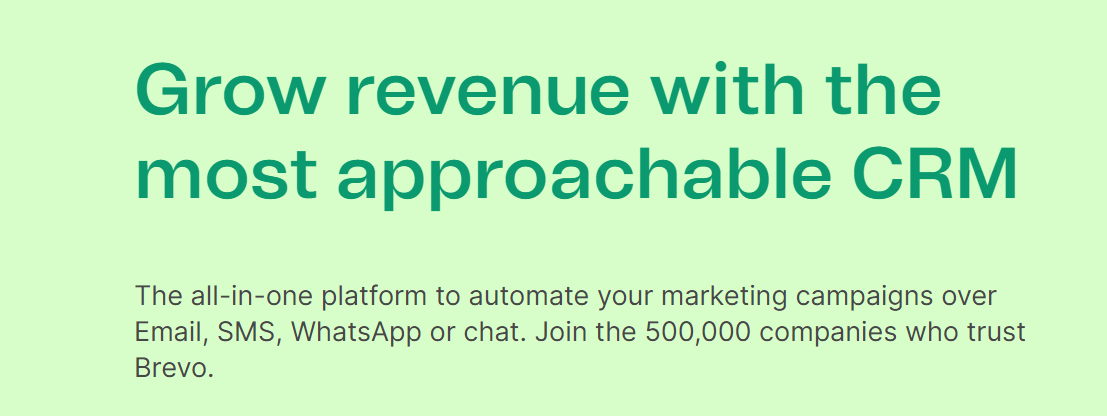
Brevo for email provides a robust platform for streamlined email marketing. Renowned for its versatility, it offers powerful tools to create, automate, and optimize email campaigns. With a focus on personalization and engagement, Brevo enables efficient email management, segmentation, and analytics, fostering impactful customer interactions and conversions.
Best for: Email marketing.
Key features:
- Transactional emails: Sends emails en masse and on time.
- Inbound parsing: Makes every email two-way.
- Personalization: Allows the creation of personalized emails.
- Email API: Guarantees an email delivery rate of 100%.
Pros:
- Makes creating email marketing campaigns simple.
- Customer support is very responsive.
- Has tons of features for the price.
Cons:
- Some emails get sent into the spam folder that shouldn’t.
Pricing: Brevo pricing page.
Gmail

Gmail, part of Google Workspace, offers professional email hosting with robust features. Renowned for its intuitive interface, it provides a custom email address, advanced security, ample storage, collaborative tools, and seamless integration with other Google Workspace apps, enhancing productivity and communication for businesses.
Best for: Budget email hosting.
Key features:
- Storage: Gmail offers generous storage space for emails and attachments, typically around 15 GB for free accounts, and more with paid plans.
- Search: Powerful search functionality allows users to find specific emails using keywords, sender, date, or other criteria.
- Labels and filters: Emails can be organized using labels and filters to categorize and sort messages automatically.
- Customization: Users can customize the layout, themes, and settings according to their preferences.
- Security: Robust security measures, including spam filters, phishing detection, two-factor authentication, and encrypted connections to protect user data.
Pros:
- Accessible across multiple devices via web browsers or dedicated mobile apps for iOS and Android.
- Offers predictive text suggestions as you compose emails to help speed up the writing process.
- Automatically identifies important emails and separates them from less important ones based on your preferences and usage.
Cons:
- Getting direct customer support from Google can be challenging, especially for free account users.
Pricing: Gmail pricing page.
MailerLite

MailerLite is an intuitive email marketing platform designed for simplicity and efficiency. With user-friendly drag-and-drop tools, it enables seamless creation of professional newsletters. Offering automation, subscriber management, and detailed analytics, MailerLite empowers businesses to engage audiences effectively. Its affordable pricing and accessible features make it a popular choice for marketers.
Best for: Newsletter creation.
Key features:
- Drag-and-drop editor: Intuitive and user-friendly interface for creating visually appealing newsletters and email campaigns without needing coding skills.
- Email automation: Set up automated email sequences based on subscriber actions or time triggers to nurture leads or engage subscribers.
- Subscriber management: Tools to manage subscriber lists, segment audiences, and personalize content for better targeting.
- Responsive templates: Responsive and customizable email templates designed to look good on various devices and screen sizes.
- RSS campaigns: Automation to send blog updates or content via email using RSS feed integration.
Pros:
- Integration with various third-party platforms and tools for enhanced functionality and workflow optimization.
- Competitive pricing plans, including a free tier with limited features, making it accessible for small businesses and startups.
- Allows testing different email variations to optimize open rates, click-through rates, and overall campaign performance.
Cons:
- Customization options might be somewhat limited compared to more advanced email marketing platforms.
Pricing: MailerLite pricing page.
Mailbird

Mailbird is a streamlined email client focused on simplifying communication. Known for its intuitive design and unified inbox, Mailbird provides a seamless email management experience. Emphasizing productivity, it offers a customizable interface and integrates easily with various productivity apps, enhancing workflow efficiency for users.
Best for: Client communication.
Key features:
- Unified inbox: Aggregates emails from multiple accounts into a single, organized interface for streamlined management.
- Customizable interface: Allows users to personalize the layout, themes, and settings according to their preferences.
- Snooze feature: Temporarily removes emails from the inbox and resurfaces them later at a specified time, aiding in better email management.
- LinkedIn lookup: Integration with LinkedIn to view and connect with contacts directly from the email client.
- Multiple account support: Manages and accesses multiple email accounts within a single interface for convenience.
Pros:
- Offers various keyboard shortcuts for quick navigation and actions within the application.
- Allows users to customize and manage notification settings for each account separately.
- Focuses on providing a fast and efficient email management experience for users.
- Offers a free plan.
Cons:
- Mailbird is primarily available for Windows, which might not cater to users preferring other operating systems like macOS or Linux.
Pricing: Mailbird pricing page.
Social media management
NapoleonCat

NapoleonCat is a social media management tool catering to businesses, offering robust features for scheduling, analytics, and engagement across various platforms. With a focus on efficiency, it facilitates content planning, team collaboration, and in-depth performance analysis, streamlining social media marketing efforts for improved brand presence and audience engagement.
Best for: Content planning.
Key features:
- Social media scheduling: Allows scheduling posts across multiple platforms like Facebook, Instagram, Twitter, LinkedIn, and YouTube.
- Content calendar: Provides a visual overview of scheduled posts, ensuring consistent and organized content sharing.
- Automated publishing: Allows for automation of posting schedules, optimizing timing for maximum audience reach.
- Social media monitoring: Tracks brand mentions, comments, and messages across various platforms in one unified inbox.
Pros:
- Offers insights into competitors’ social media strategies and performance metrics.
- Facilitates collaboration among team members with role-based permissions and workflow management.
- Tracks the performance of hashtags used in posts to optimize content strategy.
Cons:
- While it supports major platforms, some niche or emerging social media networks might not be fully integrated.
Pricing: NapoleonCat pricing page.
Buffer

Buffer is a user-friendly social media management tool, simplifying content scheduling and engagement across various platforms. With its intuitive interface, it enables easy scheduling, analytics, and collaboration. Known for its simplicity, Buffer assists businesses in streamlining their social media strategies for improved audience engagement and growth.
Best for: Post scheduling.
Key features:
- Social media scheduling: Allows scheduling posts across multiple platforms like Facebook, Instagram, Twitter, LinkedIn, and Pinterest.
- Browser extension: Enables quick sharing of web content directly to social media platforms.
- Customized scheduling: Offers options to customize posting schedules based on audience behavior and optimal times.
- RSS feed integration: Allows automation of content sharing from RSS feeds to social media platforms.
- Post composer: Easy-to-use interface for creating and editing social media posts within the platform.
Pros:
- Generates reports for analyzing post reach, engagement rates, and audience demographics.
- Assists in tracking and analyzing the effectiveness of social media campaigns.
- Provides an organized view of scheduled posts, aiding in strategic content planning.
Cons:
- The free version of Buffer has limitations in terms of the number of posts and platforms that can be managed.
Pricing: Buffer pricing page.
Hootsuite

Hootsuite is a robust social media management platform known for its comprehensive tools catering to businesses. It simplifies scheduling, analytics, and team collaboration across various platforms. With a user-friendly interface, it empowers users to streamline social media strategies and enhance audience engagement effectively.
Best for: Audience engagement.
Key features:
- Social listening: Monitors brand mentions, comments, and messages across various platforms in a unified dashboard.
- Ad management: Manages and tracks advertising campaigns on Facebook directly within the platform.
- Audience engagement: Enables interaction with audiences by responding to comments, messages, and mentions.
- Security and permissions: Provides security features and team permissions to safeguard social media accounts.
Pros:
- Enables management and scheduling of posts across various social media platforms from a single dashboard.
- Provides a content calendar for organized scheduling and strategic planning of social media posts.
- Tracks post performance, audience engagement metrics, and campaign success across different social networks.
Cons:
- Access to advanced features and analytics is limited in lower-tier plans, requiring higher-priced subscriptions for full functionality.
Pricing: Hootsuite pricing page.
Iconosquare

Iconosquare is a comprehensive social media analytics and management platform tailored for businesses. It allows businesses to track performance, understand audience behavior, and optimize social media strategies across platforms, fostering improved engagement and growth strategies.
Best for: Performance tracking.
Key features:
- Analytics and insights: Detailed analytics on post performance, engagement metrics, audience demographics, and growth trends across various social media platforms.
- Competitor analysis: Provides insights into competitors’ strategies, performance metrics, and benchmarking for informed decision-making.
- Audience engagement metrics: Tracks audience interactions, response rates, and sentiment analysis for better engagement strategies.
- Hashtag tracking: Monitors and analyzes the performance of hashtags to optimize content strategies.
- Customizable reports: Generates customizable reports for in-depth analysis and client reporting.
Pros:
- Tools for monitoring comments, messages, and mentions to engage with the audience effectively.
- Provides insights and metrics for analyzing the effectiveness of paid advertising campaigns.
- Helps in identifying and analyzing potential influencers for collaborations.
- Offers recommendations and insights to improve post reach, engagement, and performance.
Cons:
- Utilizing all advanced features effectively might require time and a learning curve for new users.
- Real-time engagement with comments and messages might not be as seamless compared to dedicated social media management tools.
Pricing: Iconosquare pricing page.
BuzzSumo

BuzzSumo stands as a versatile content research tool, renowned for its insightful analytics. It empowers businesses by unveiling content trends, revealing influential voices, and aiding in content strategy refinement. With its robust data-driven approach, BuzzSumo fuels informed decisions, amplifying content effectiveness and audience engagement strategies.
Best for: Content research.
Key features:
- Content discovery: Allows users to discover top-performing content across various topics and platforms.
- Content analysis: Provides in-depth analysis of content performance, including social shares, backlinks, and engagement metrics.
- Influencer identification: Helps in identifying influential voices in specific niches or industries.
- Trending topics: Tracks and displays trending topics and discussions on social media platforms.
- Competitor analysis: Offers insights into competitors’ content strategies and performance metrics.
Pros:
- Provides notifications for mentions of specific keywords or brand mentions across the web.
- Assists in researching content for SEO purposes and identifying link-building opportunities.
- Aids in refining content strategies by providing data-driven insights.
Cons:
- The tool might have limitations in providing real-time data, especially for rapidly changing trends.
- The interface might be overwhelming initially due to the extensive array of features and analytics.
Pricing: BuzzSumo pricing page.
SocialFlow
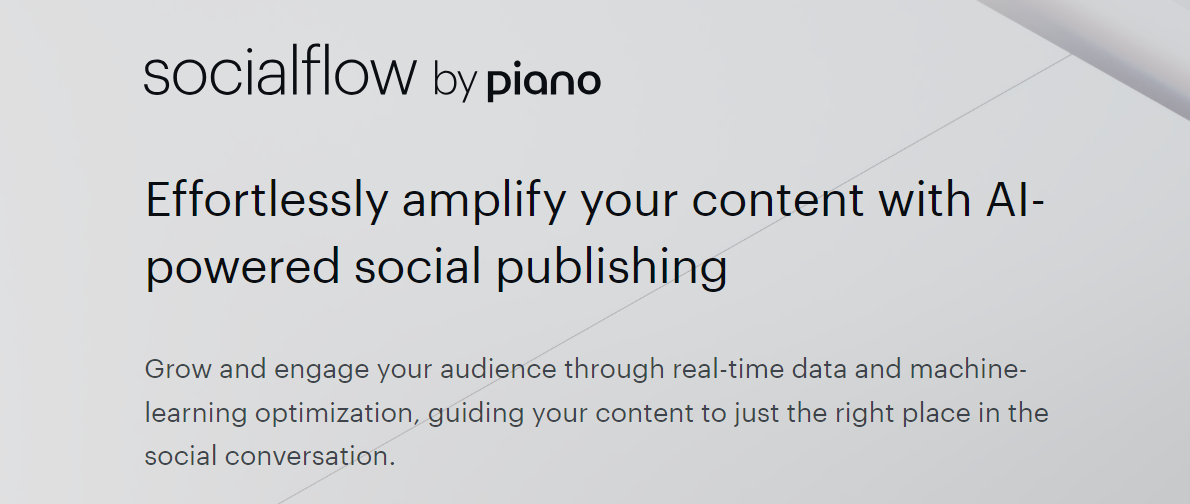
SocialFlow stands as an advanced social media management platform, revered for its sophisticated analytics and optimization capabilities. Tailored for businesses, it leverages data-driven insights to enhance content strategy and audience engagement. With its focus on optimizing post performance, it empowers brands to maximize their social reach effectively.
Best for: Post optimization.
Key features:
- Content optimization: Utilizes data and analytics to optimize content for better performance and engagement.
- Scheduling and publishing: Allows scheduling and publishing of posts across various social media platforms.
- Audience insights: Provides insights into audience behavior, preferences, and engagement patterns.
- Content recommendations: Provides content suggestions and recommendations for improved engagement.
Pros:
- Uses artificial intelligence to optimize posting times and content for maximum impact.
- Facilitates collaboration among team members with permissions and workflow management.
- Manages and tracks social media campaigns for effectiveness and ROI.
Cons:
- Utilizing the full potential of AI-driven optimization might require a learning curve for new users.
Pricing: SocialFlow demo request.
Post Planner
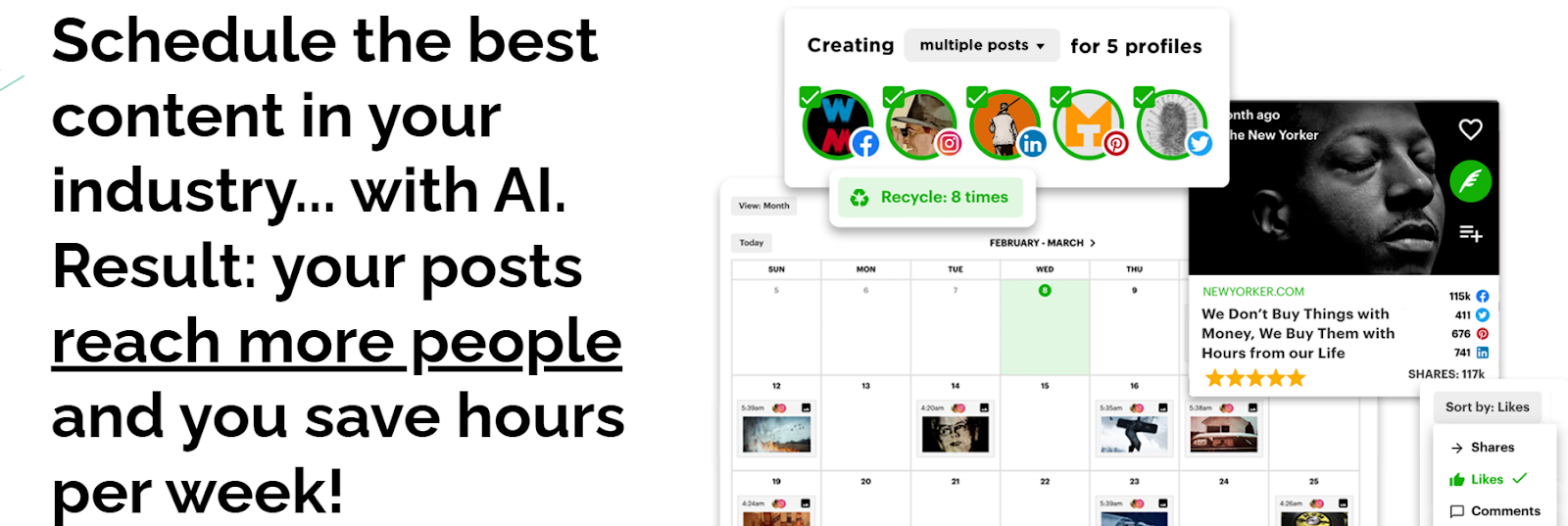
Post Planner is a social media management tool focused on content curation and scheduling. It simplifies content discovery, offering a library of engaging posts and trending topics. Known for its user-friendly interface, it aids in strategic scheduling, enhancing social media presence and audience engagement for businesses and individuals.
Best for: Content discovery.
Key features:
- Content discovery: Provides a library of engaging posts and trending topics for easy content curation.
- Content categorization: Organizes content into categories for better planning and variety in posts.
- Queue management: Manages and optimizes post scheduling in a queue for consistent sharing.
- Content suggestions: Offers content ideas and suggestions for increased engagement.
- RSS feed integration: Enables automation of content sharing from RSS feeds.
Pros:
- Allows scheduling of posts across various social media platforms.
- Tailors posting schedules based on audience behavior and optimal times.
- Facilitates teamwork with multiple user access and collaboration features.
- Offers a free plan.
Cons:
- Offers limited analytics, which might not provide detailed insights for advanced strategy development.
Pricing: Post Planner pricing page.
SocialPilot
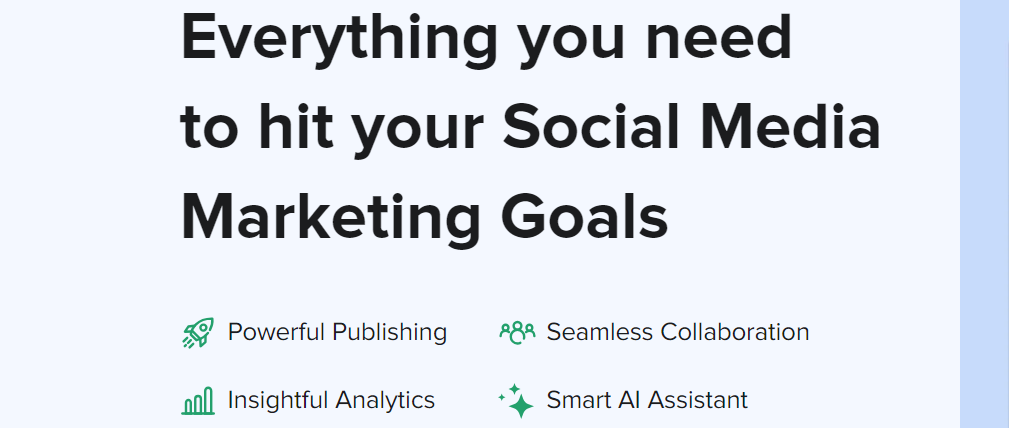
SocialPilot is a robust social media management tool offering comprehensive features for scheduling, analytics, and collaboration. It streamlines content management across various platforms, aiding in strategic scheduling and efficient audience engagement strategies for improved brand presence.
Best for: Brand presence.
Key features:
- Bulk scheduling: Allows uploading and scheduling multiple posts simultaneously for convenience.
- Content suggestions: Provides content ideas and recommendations for improved engagement.
- Client management: Features for managing multiple clients or brands within a single dashboard.
- White-labeling: Allows customization and branding for agencies and businesses.
Pros:
- Organizes and manages posting schedules for optimized content sharing.
- Assists in monitoring comments, messages, and mentions for better interaction.
- Provides a visual calendar for organized content planning and scheduling.
Cons:
- While supporting major platforms, some emerging or niche social networks might not be fully integrated.
Pricing: SocialPilot pricing page.
Communication
Slack

Slack stands as a versatile collaboration platform, streamlining communication among teams with channels, direct messaging, and file sharing. Known for its user-friendly interface and integrations, Slack fosters efficient teamwork, offering a centralized hub for discussions, project management, and seamless collaboration across diverse work environments.
Best for: Direct messaging.
Key features:
- Channels: Organizes communication into channels based on topics, teams, or projects for focused discussions.
- Direct messaging: Allows one-on-one or group messaging for quick and private conversations.
- File sharing: Facilitates sharing files, documents, images, and more within conversations.
- Integrations: Integrates with various apps and tools for enhanced functionality and workflow.
- Searchable history: Provides a searchable archive of conversations and shared files for easy retrieval.
Pros:
- Supports automation through bots and apps for streamlined workflows.
- Allows customization with themes, emojis, and personalized notifications.
- Provides tools like polls, reminders, and shared to-do lists for efficient teamwork.
- Offers various security measures like data encryption and two-factor authentication.
Cons:
- The free plan only stores messages for 30 days.
- Channels can multiply rapidly, requiring active management to avoid confusion or redundant channels.
Pricing: Slack pricing page.
Zoom

Zoom revolutionized remote communication, becoming synonymous with video conferencing. Known for its simplicity and reliability, it offers seamless virtual meetings and webinars. With intuitive controls and robust capabilities, Zoom facilitates global connectivity, empowering businesses, educators, and individuals to collaborate effectively across distances.
Best for: Video conferencing.
Key features:
- Video conferencing: Hosts high-quality video meetings for individuals and groups.
- Audio conferencing: Allows participants to join via phone, providing flexibility in connectivity.
- Screen sharing: Enables sharing of screens for presentations or demonstrations.
- Chat function: Facilitates instant messaging during meetings for quick communication.
- Recording and transcription: Records meetings and offers transcription services for later reference.
Pros:
- Provides the option to use virtual backgrounds during video calls.
- Integrates with calendars to schedule and manage meetings efficiently.
- Offers tools for conducting polls and surveys during meetings.
- Hosts webinars and large-scale events with various interactive features.
Cons:
- Free version limits meeting durations, which might be a drawback for longer discussions.
- Requires stable and sufficient internet bandwidth for optimal performance.
Pricing: Zoom pricing page.
Loom

Loom redefines communication with its seamless video messaging platform. This tool simplifies sharing thoughts and instructions through screen and camera recordings, streamlining remote collaboration. Renowned for its ease of use and accessibility, Loom offers a personalized touch, fostering efficient and engaging communication across teams and projects.
Best for: Video messaging.
Key features:
- Screen recording: Captures screen activity with audio, aiding in demonstrations and tutorials.
- Camera recording: Allows recording using the webcam for personalized video messages.
- Instant sharing: Enables quick sharing of recorded videos through links or embeds.
- Annotation and editing: Offers tools for annotating and editing videos for clarity and emphasis.
- Viewer engagement: Tracks viewer interactions and engagement with shared videos.
Pros:
- Organizes and shares videos within team libraries for easy access.
- Adds customizable buttons for guiding viewers to take specific actions.
- Provides control over privacy settings and video access permissions.
- Offers insights into video performance and viewer behavior for assessment and improvement.
Cons:
- Lacks advanced editing options compared to dedicated video editing software.
- Lack of offline functionality might be limiting for users in areas with unstable internet connectivity.
Pricing: Loom pricing page.
Microsoft Teams

Microsoft Teams stands as an integrated collaboration platform, fostering seamless teamwork within organizations. It unifies chats, meetings, file sharing, and app integration in a single hub. Known for its versatility, it streamlines communication, project management, and remote collaboration, amplifying productivity across diverse work environments.
Best for: Dynamic collaboration.
Key features:
- Chat: Facilitates one-on-one and group messaging with threaded conversations.
- Meetings: Hosts audio and video meetings with screen sharing and recording options.
- File sharing: Allows sharing and collaboration on files within channels or chats.
- Integrated apps: Integrates with various Microsoft and third-party apps for enhanced functionality.
- Channels: Organizes conversations, files, and meetings into specific channels based on teams or topics.
Pros:
- Enables real-time editing of documents within Teams using Office 365 apps.
- Integrates with Microsoft Planner or other task management tools for project management.
- Offers advanced security features and compliance capabilities.
- Supports bots for automating tasks and improving productivity.
Cons:
- Requires significant system resources, potentially causing performance issues on lower-end devices.
- Relies heavily on the Microsoft ecosystem, limiting interoperability with non-Microsoft apps.
Pricing: Microsoft Teams pricing page.
Discord

Discord stands as a versatile communication platform initially tailored for gaming communities. Evolving beyond gaming, it offers voice, video, and text chat, fostering diverse communities worldwide. Renowned for its user-friendly interface and extensive customization, Discord encourages collaboration, social interaction, and content creation across various interests and industries.
Best for: Casual communication.
Key features:
- Voice chat: Allows high-quality voice calls with low latency.
- Video chat: Hosts video calls for face-to-face communication.
- Text chat: Offers text-based communication through servers and channels.
- Server creation: Enables users to create servers for specific communities or topics.
- Channel organization: Organizes discussions into text and voice channels within servers.
Pros:
- Facilitates one-on-one or group messaging.
- Allows sharing of files, images, and videos within conversations.
- Assigns roles and permissions to manage user access within servers.
- Provides community-driven features like moderation tools and server verification.
Cons:
- Larger communities might face moderation challenges due to limited tools.
- Can consume significant system resources, impacting device performance.
Pricing: Discord pricing page.
Google Workspace
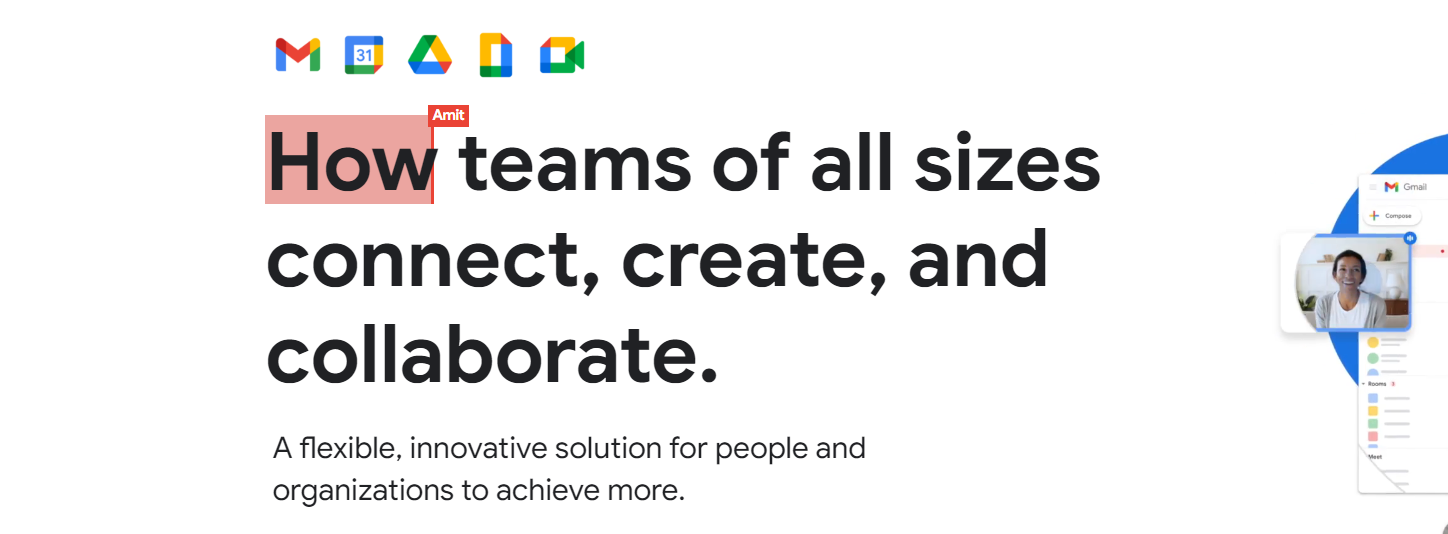
Google Workspace, formerly G Suite, offers a suite of productivity tools like Gmail, Drive, Docs, and Meet, fostering seamless collaboration. Known for cloud-based accessibility and real-time editing, it streamlines teamwork, communication, and file management. Google Workspace redefines workflow efficiency, catering to diverse business and organizational needs.
Best for: Complete use of Google products.
Key features:
- Email capabilities: Advanced email management, such as data loss prevention, custom email routing, and integration with archiving solutions.
- Drive security: Enhanced data control with advanced Drive security features like data loss prevention (DLP), advanced audit reports, and granular access controls.
- Advanced video conferencing: Extended capabilities in Google Meet, including larger meeting sizes, live streaming for larger audiences, and more advanced admin controls.
- Enhanced team collaboration: Advanced features in Google Docs, Sheets, and Slides, such as team-driven sharing settings, version history tracking, and commenting options.
- Admin controls: Granular control for administrators, including user activity monitoring, device management, and security center for threat intelligence.
Pros:
- Offers a suite of Google tools for seamless collaboration and productivity.
- Provides easy access to files and tools from any device with internet connectivity.
- Allows multiple users to edit documents simultaneously, enhancing teamwork.
- Scales well for businesses of various sizes, from small teams to large enterprises.
Cons:
- Relying heavily on Google’s ecosystem might limit interoperability with other platforms.
- Concerns about data privacy and security, especially for sensitive information.
Pricing: Google Workspace pricing page.
Flock

Flock stands as a robust team communication and collaboration platform, offering seamless messaging, video conferencing, and file sharing. Renowned for its user-friendly interface and integrations, Flock enhances teamwork, streamlines project management, and fosters efficient remote collaboration across diverse industries and team sizes.
Best for: Team productivity.
Key features:
- Messaging: Offers real-time messaging for one-on-one and group conversations.
- Channels: Organizes discussions into channels for teams, projects, or topics.
- Video conferencing: Hosts video meetings and calls within the platform.
- File sharing: Facilitates sharing files, documents, and media within conversations.
- Collaborative notes: Allows creating and sharing notes for team collaboration.
Pros:
- Integrates task management tools for better project coordination.
- Provides a search feature for quick retrieval of information.
- Conducts polls and surveys within the platform for quick feedback.
- Enables screen sharing for remote collaboration and troubleshooting.
Cons:
- There can be limitations in handling larger teams or scaling for extensive use.
- Lacks some advanced functionalities compared to more robust collaboration tools.
Pricing: Flock pricing page.
GoToMeeting
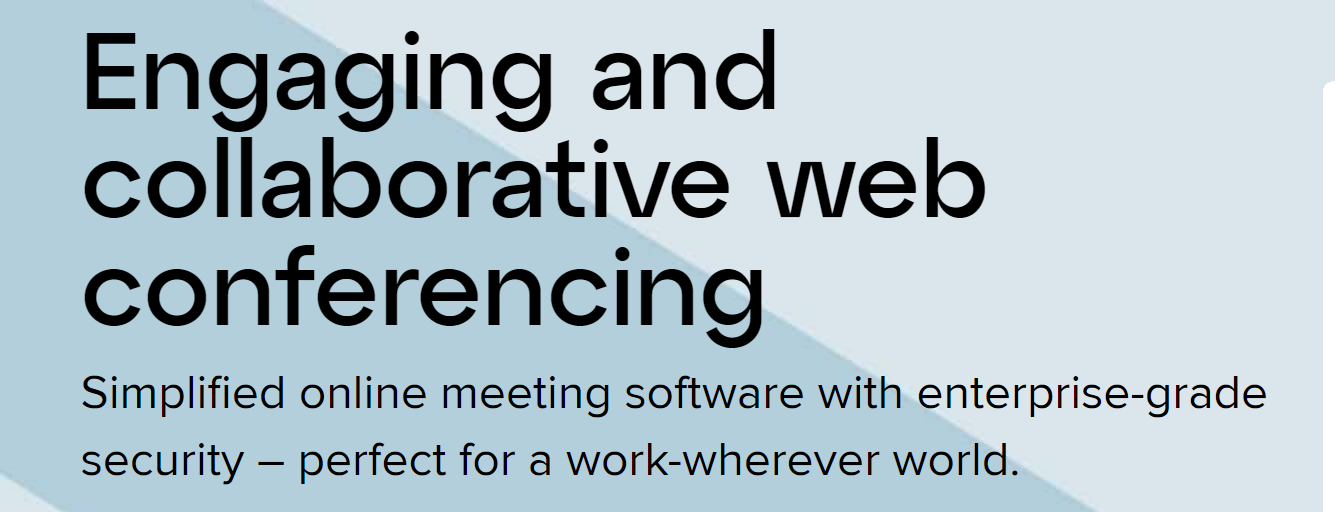
GoToMeeting stands as a leading video conferencing platform, renowned for its reliability and simplicity. Offering seamless screen sharing, HD video, and versatile collaboration tools, it empowers businesses globally. With user-friendly features and robust security, GoToMeeting fosters productive virtual meetings, enhancing communication across teams and industries.
Best for: HD video conferencing.
Key features:
- HD video conferencing: Hosts high-definition video meetings for clear communication.
- Screen sharing: Enables participants to share their screens for presentations or demonstrations.
- Meeting recording: Allows recording of meetings for later reference or sharing.
- Meeting scheduling: Integrates with calendars to schedule and manage meetings efficiently.
- Security measures: Provides encryption and secure meeting links for privacy and confidentiality.
Pros:
- Conducts webinars and large-scale online events with interactive features.
- Offers both VoIP and dial-in options for flexible audio connectivity.
- Allows in-meeting chat for quick communication among participants.
- Provides options for customization based on meeting preferences.
Cons:
- The number of participants allowed in meetings is restricted in certain plans.
Pricing: GoToMeeting pricing page.
Website builder
Squarespace

Squarespace is a platform giving individuals and businesses the ability to create stunning websites effortlessly. Its intuitive interface offers versatile templates and tools for seamless customization. With integrated hosting and robust features for e-commerce, blogging, and design, Squarespace simplifies website building, making it accessible to all skill levels.
Best for: Freelancers.
Key features:
- Templates: Professionally designed and customizable templates for various industries.
- E-commerce: Built-in tools for online stores, including inventory management and payment processing.
- Blogging tools: Integrated blogging features with social sharing and scheduling.
- SEO tools: Optimization features to improve search engine visibility.
- Domain hosting: Simplified domain purchase and management.
Pros:
- Offers reliable and secure hosting services.
- Integrates hosting, domain, and design tools.
- Has robust features for online stores.
- Offers responsive customer service and extensive knowledge base.
Cons:
- For certain plans, Squarespace charges transaction fees on sales.
- Has fewer third-party integrations compared to some other platforms.
Pricing: Squarespace pricing page.
Weebly

Weebly is a versatile website builder that fosters creativity through its user-friendly platform. It enables effortless website creation for diverse needs. With a focus on simplicity, it empowers individuals and businesses to establish a unique online presence without requiring extensive technical expertise, fostering growth and innovation.
Best for: Small businesses.
Key features:
- App center: Access to various apps and third-party integrations.
- Blogging tools: Integrated blogging platform with scheduling and social sharing.
- Mobile responsiveness: Automatic adaptation for mobile devices.
- Drag-and-drop builder: Intuitive interface for easy content customization.
- Templates: Professionally designed themes for various industries.
Pros:
- It has responsive customer support via chat, email, and a knowledge base.
- Simplified domain purchase and management.
- Offers tools to optimize sites for search engines.
Cons:
- Has limited deep customization compared to some other platforms.
Pricing: Weebly pricing page.
Wix
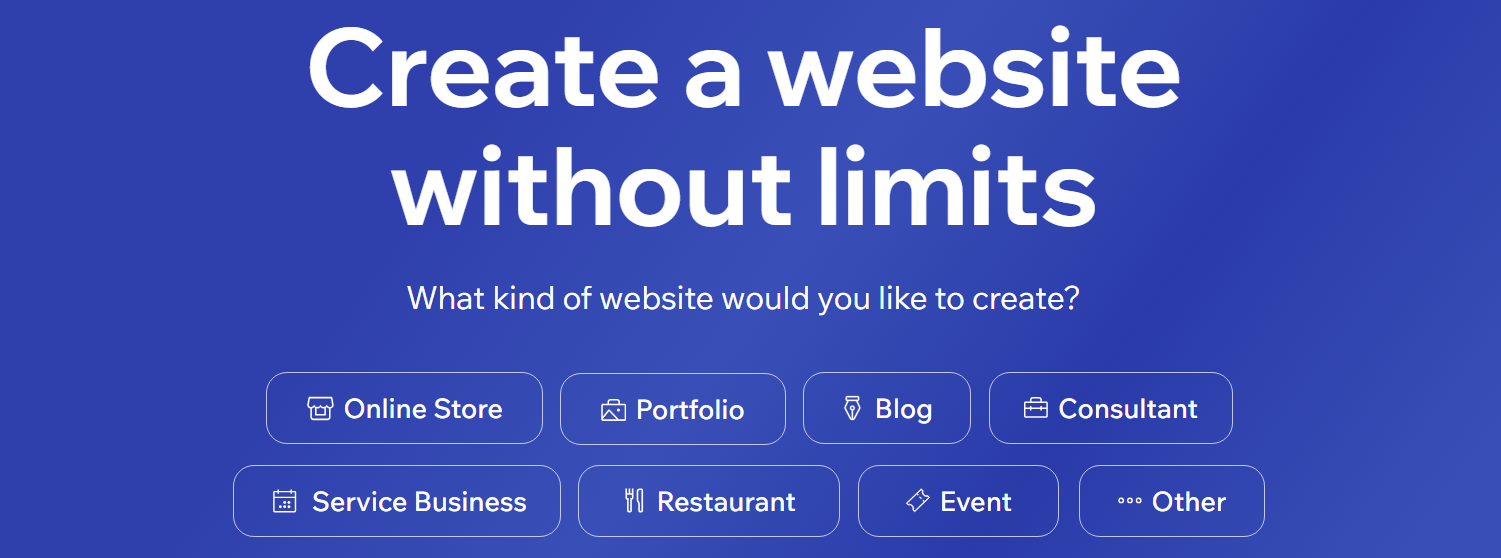
Wix is a website builder that empowers users to craft stunning online platforms effortlessly. Its intuitive interface fosters creativity, catering to diverse needs without technical barriers. Emphasizing design freedom, Wix enables individuals and businesses to establish unique digital identities, promoting growth and innovation in the online sphere.
Best for: Branding.
Key features:
- App market: Access to a wide array of apps and integrations.
- SEO tools: Features to optimize websites for search engines.
- Blogging platform: Integrated platform for content creation and scheduling.
- Domain hosting: Simplified domain purchase and management.
- Analytics: Insights into site performance and visitor behavior.
Pros:
- Offers tons of unique design options.
- Provides advanced tools for e-commerce.
- Users have reported excellent customer service.
Cons:
- Free plan includes Wix ads on the website.
- There are storage caps on lower-tier plans.
Pricing: Wix pricing page.
Shopify

Shopify is a leading e-commerce platform that gives entrepreneurs the ability to build and scale online businesses seamlessly. Its robust ecosystem goes beyond selling, fostering a community-driven approach to commerce. With a focus on innovation and adaptability, Shopify supports diverse ventures, facilitating growth and success in the digital marketplace.
Best for: E-commerce.
Key features:
- Store builder: Intuitive interface for creating and customizing online stores.
- Product management: Tools for inventory, variants, SKUs, and collections.
- Payment processing: Integrated payment gateways for secure transactions.
- Shopping cart: Seamless and customizable shopping cart functionality.
- Shipping: Flexible shipping rates, labels, and fulfillment integration.
Pros:
- Offers marketing tools like SEO, social media integration, and discount code creation.
- Offers insights into sales, customer behavior, and store performance.
- Supports various payment gateways and currencies.
- Offers secure hosting and compliance with industry standards.
Cons:
- Some essential features might need additional paid apps.
- There are some limitations in SEO flexibility compared to standalone platforms.
Pricing: Sopify pricing page.
WordPress

WordPress, a content management system, empowers users to create dynamic websites and blogs. Its open-source nature fosters a vast community, driving innovation and customization. With flexibility at its core, WordPress accommodates various needs, from personal blogs to complex business sites, shaping the internet’s diverse landscape.
Best for: Blogging.
Key features:
- Content management: Easy creation, editing, and organization of content.
- Themes: Diverse and customizable themes for varied designs.
- Plugins: Extensive library for added functionalities and customization.
- SEO: Optimization tools and plugins for improved search engine visibility.
- Media management: Image, audio, and video handling within the platform.
Pros:
- Has plugins for building online stores like WooCommerce.
- Has plugins enabling multilingual site creation.
- Offers control over user roles and permissions.
- Suitable for small blogs to large enterprise websites.
Cons:
- Regular updates and security checks can be time-consuming.
- Vulnerable to hacking if not regularly updated.
Pricing: WordPress pricing page.
Jimdo

Jimdo is a website builder that empowers users to create professional sites effortlessly. Its intuitive platform emphasizes simplicity, enabling diverse customization without technical hurdles. With a focus on ease and adaptability, Jimdo fosters online presence for individuals and businesses, fostering growth in the digital landscape.
Best for: Simple websites.
Key features:
- E-commerce: Tools for creating and managing online stores.
- SEO tools: Features to optimize websites for search engines.
- Blog functionality: Integrated blogging platform for content creation.
- Analytics: Insights into site performance and visitor behavior.
- Domain hosting: Simplified domain purchase and management
Pros:
- Responsive assistance through multiple channels.
- Intuitive drag-and-drop interface for easy website building.
- Professionally designed themes for various industries.
Cons:
- Changing templates may cause content rearrangement.
Pricing: Jimdo pricing page.
GoDaddy
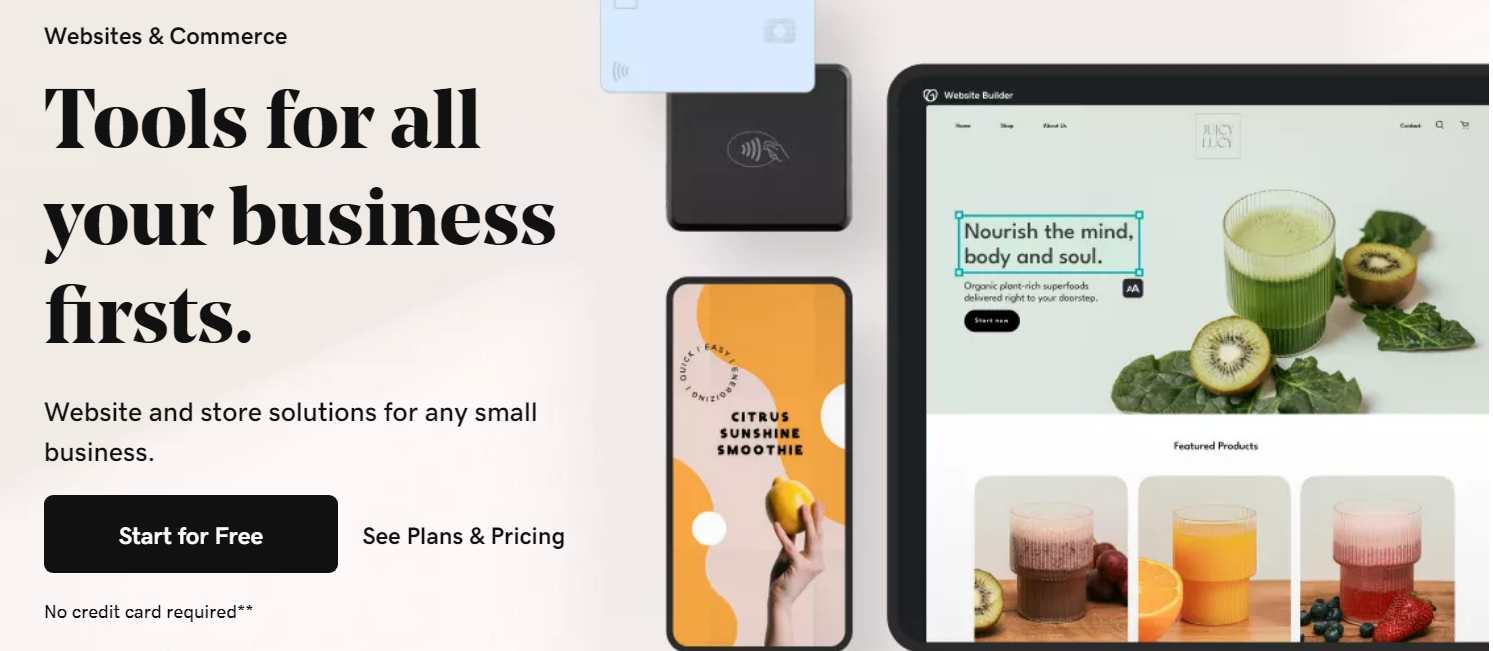
GoDaddy is a web services platform, that aids individuals and businesses in establishing their online presence effortlessly. Known for domain registration and hosting, it offers an extensive suite of tools. With a focus on accessibility, GoDaddy simplifies website management, fostering growth and innovation in the digital sphere.
Best for: Domain registration.
Key features:
- Domain registration: Simplified domain search, purchase, and management.
- Website builder: Easy-to-use tools for website creation and customization.
- Hosting services: Reliable hosting solutions for various website needs.
- Email marketing: Campaign management tools for effective email marketing.
- WordPress hosting: Hosting optimized specifically for WordPress websites.
Pros:
- Offers excellent customer support.
- Makes the domain registration process extremely easy.
- Integrates with other website builders like WordPress.
Cons:
- They use aggressive upselling tactics during the checkout process.
Pricing: GoDaddy pricing page.
Webflow

Webflow is a powerful web design platform that bridges the gap between design and development. With a visual interface, it empowers users to craft sophisticated websites without code. This comprehensive toolset emphasizes design freedom, enabling creative control while fostering efficient and responsive website creation for diverse needs.
Best for: No-code web design.
Key features:
- Design freedom: Extensive design customization without coding.
- Visual editor: Intuitive drag-and-drop interface for website creation.
- Responsive design: Automatic adaptation for various devices.
- CMS capabilities: Content management system for easy content editing.
- Animations and interactions: Ability to create dynamic effects without code.
Pros:
- Offers reliable hosting and domain connection.
- Provides tools for building and managing online stores.
- Provides tools to optimize sites for search engines.
- Users have reported excellent customer support.
Cons:
- Steeper learning curve, especially for beginners.
- Complexity increases with advanced design and interactions.
Pricing: Webflow pricing page.
Time management
Clockwise

Clockwise is an intelligent calendar assistant that optimizes schedules for productivity. Its AI-driven approach automates meeting scheduling, respecting personal time and priorities. By analyzing work patterns, Clockwise orchestrates focused, uninterrupted blocks, fostering a balanced work-life balance. With a seamless interface, it empowers individuals and teams to reclaim control over their calendars.
Best for: Calendar management.
Key features:
- Smart calendar assistant: AI-driven scheduling for optimal time management.
- Automatic meeting rescheduling: Adjusts meetings to create focused blocks of time.
- Focus time: Protects uninterrupted blocks for concentrated work.
- Calendar insights: Analyzes work patterns to improve scheduling efficiency.
Pros:
- Streamlines scheduling across teams and departments.
- Seamless integration with calendars like Google Calendar and Outlook.
- Considers individual preferences and priorities.
- Has an intuitive design for easy navigation and use.
Cons:
- Some features are restricted in the free version.
- It might take some users time to adjust to the AI-driven scheduling approach.
Pricing: Clockwise pricing page.
Toggl

Toggl, a time tracking tool, empowers individuals and teams to efficiently manage tasks. With a simple interface, it meticulously tracks time spent on activities, aiding productivity analysis. Beyond tracking, Toggl offers insights into workflow patterns, fostering a mindful approach to time management for improved efficiency and focus.
Best for: Time tracking.
Key features:
- Time tracking: Precise tracking of work hours and tasks.
- Manual time entry: Ability to add time entries manually.
- Timer functionality: Stopwatch timer for real-time tracking.
- Project and task organization: Categorization of work into projects and tasks.
- Reports and analytics: Insights into time spent, productivity, and trends.
Pros:
- Monitors billable hours for client projects.
- Has tools for team time management and coordination.
- Offers seamless integration with various project management tools.
- Syncs with calendars for streamlined scheduling.
Cons:
- Some users encounter issues with time zone differences in tracking.
- Customizing reports has limitations in the free plan.
Pricing: Toggl pricing page.
Clockify

Clockify is a time tracking tool that allows users to manage tasks efficiently. With a simple interface, it meticulously tracks time spent on projects, aiding productivity analysis. Beyond tracking, Clockify offers insights into workflow patterns, fostering mindful time management for improved efficiency and focused work allocation.
Best for: Task management.
Key features:
- Time tracking: Precise tracking of work hours and tasks.
- Project organization: Categorization of tasks into projects and sub-projects.
- Client and team management: Monitoring time spent on client projects and team collaboration.
- Reports and analytics: Insights into time spent, productivity, and trends.
- Billable hours tracking: Monitoring billable hours for client invoicing.
Pros:
- Sets different access levels for team members.
- Integrates with various project management tools, like Asana and Trello.
- Allocates time blocks for focused work sessions.
- Automates the detection of idle time for accurate tracking.
Cons:
- The mobile app lacks some functionalities compared to the web version.
- Some users have reported occasional inaccuracies in detecting idle time.
Pricing: Clockify pricing page.
TimeCamp

TimeCamp is an efficient time tracking tool that optimizes productivity and workflow management. Its intuitive platform meticulously tracks tasks, offering insights into time allocation for improved efficiency. With a focus on accurate reporting and analysis, TimeCamp empowers individuals and teams to streamline operations and maximize productivity effortlessly.
Best for: Workflow management.
Key features:
- Automatic time tracking: Precise tracking of work hours and activities.
- Project and task tracking: Categorization of tasks into projects and sub-tasks.
- Productivity reports: Insights into time spent, productivity levels, and trends.
- Timesheets: Detailed breakdown of time spent on different tasks.
- Team management: Collaboration features for team members and project coordination.
Pros:
- Generates invoices based on tracked billable hours.
- Monitors and manages team attendance and work hours.
- Integrates with various productivity tools, like Airtable and Monday.
Cons:
- Users report occasional glitches in tracking accuracy.
Pricing: TimeCamp pricing page.
Harvest

Harvest is a robust time tracking and invoicing tool that empowers users to efficiently manage projects and billable hours. With an intuitive interface, it meticulously tracks time, aiding project insights and invoicing accuracy. Beyond tracking, Harvest streamlines operations, fostering productivity and financial management effortlessly for businesses and freelancers.
Best for: Invoicing.
Key features:
- Time tracking: Accurate tracking of billable hours and tasks.
- Expense tracking: Monitoring and managing project expenses.
- Invoicing: Creating and sending professional invoices to clients.
- Client portal: Providing clients access to project-related information and invoices.
- Timesheet approval: Review and approve timesheets for accuracy.
Pros:
- Organizes and tracks project progress and tasks.
- Assigns tasks and tracks team members’ time.
- Offers detailed insights into project budgets, time spent, and profitability.
Cons:
- Some users find the interface overwhelming initially.
- There is no built-in CRM.
Pricing: Harvest pricing page.
Everhour

Everhour elevates project management with precision. Its seamless interface meticulously tracks billable hours, enhancing team efficiency. Beyond tracking, Everhour empowers teams with detailed insights, facilitating accurate invoicing and resource allocation. Its intuitive platform fosters productivity, making time management effortless for diverse projects.
Best for: Recourse allocation.
Key features:
- Project budgeting: Setting and monitoring project budgets.
- Task management: Organizing tasks and tracking time spent on each task.
- Resource planning: Allocating resources and scheduling tasks.
- Time estimates: Setting and tracking estimated time for tasks and projects.
Pros:
- Integrates with project management tools like Asana, Trello, and more.
- Generates invoices based on tracked billable hours.
- Offers detailed insights into time usage and project performance.
Cons:
- Mobile app functionality might be more limited compared to the web version.
- Setting up custom reports or features could be complex for beginners.
Pricing: Everhour pricing page.
TMetric

TMetric is an efficient time tracking tool that optimizes productivity for businesses and freelancers alike. With an intuitive interface, it meticulously records billable hours, aiding project insights and invoicing accuracy. Beyond tracking, TMetric offers comprehensive reports, fostering mindful time management for improved efficiency and focused work allocation.
Best for: Freelancers.
Key features:
- Productivity monitoring: Analyzing efficiency and work patterns.
- Client billing: Accurate client billing based on tracked time entries.
- Task management: Organizing tasks and tracking time spent on each task.
- Project tracking: Monitoring and managing project progress and budgets.
- Reporting and analytics: Detailed insights into time usage and productivity trends.
Pros:
- Provides precise tracking of billable hours and tasks.
- Works well with various project management tools.
- Accessibility through mobile devices for on-the-go tracking.
- Offers great customer support.
Cons:
- Some users find the interface overwhelming initially.
- The free plan has very limited features.
Pricing: TMetric pricing page.
Google Calendar

(Source)
Google Calendar, a versatile scheduling tool, organizes events effortlessly. Its intuitive interface allows easy event creation, reminders, and collaboration. With color-coded categories, it efficiently manages personal and professional schedules. Seamless integration with other Google services makes it a powerful planner, fostering productivity and time management.
Best for: Budget-friendly time management.
Key features:
- Event creation: Easy creation of events with details, location, and duration.
- Multiple views: Day, week, month, and agenda views for varied perspectives.
- Reminders and notifications: Alerts for upcoming events through email or mobile notifications.
- Calendar sharing: Collaborative calendars for sharing schedules with others.
- Color-coding: Categorization of events with colors for easy identification.
Pros:
- Adaptable to different time zones for global scheduling.
- Integration with Google Tasks for task management within the calendar.
- Ability to add documents or links to event details.
- Automates suggestions for event creation based on email conversations.
Cons:
- Some users may have privacy concerns due to data collection by Google.
- Has limited customization compared to some dedicated scheduling tools.
Pricing: Free!
Document management
DocuSign

DocuSign revolutionizes document handling with secure e-signatures. Its platform streamlines agreements, contracts, and approvals, enabling digital signing from anywhere. With robust security measures, it ensures compliance and legality, expediting processes for businesses. DocuSign simplifies workflows, reducing paperwork and enhancing efficiency in the digital realm.
Best for: E-signatures.
Key features:
- E-signatures: Legally binding e-signatures for documents.
- Document management: Secure storage, sharing, and organization of files.
- Workflow automation: Automated processes for document routing and approvals.
- Templates: Pre-built document templates for standardized agreements.
- Audit trail: Detailed records and tracking of document history.
Pros:
- Offers encryption and authentication for secure document handling.
- Has integration capabilities with various business applications, like Process Street.
- Ensures compliance with legal and industry standards.
- Provides collaborative tools for multiple parties to sign and review documents.
Cons:
- Relies on third-party integrations for certain functionalities.
- There are limited editing capabilities once documents are signed.
Pricing: DocuSign sales page.
PandaDoc

PandaDoc redefines document automation, revolutionizing the way businesses handle contracts and proposals. Its platform offers seamless creation, distribution, and e-signature capabilities, streamlining workflows. Empowering collaboration and efficiency, PandaDoc simplifies document management, fostering growth and agility in today’s dynamic business landscape.
Best for: Payment processing.
Key features:
- Workflow automation: Automated document workflows and approvals.
- Payment processing: Capability to collect payments within documents.
- Content library: Storage and reuse of frequently used content in documents.
- Document creation: Easy creation of professional and customizable documents.
- Document analytics: Insights into document engagement and recipient actions.
Pros:
- Offers pre-designed templates for proposals, contracts, and other documents.
- Provides real-time collaboration and commenting on documents.
- Legally binding electronic signatures for document approvals.
- Has a great content library that offers the storage and reuse of frequently used content in documents.
Cons:
- It doesn’t offer a free plan.
- Relies on third-party integrations for some functionalities.
Pricing: PandaDoc pricing page.
DocuWare
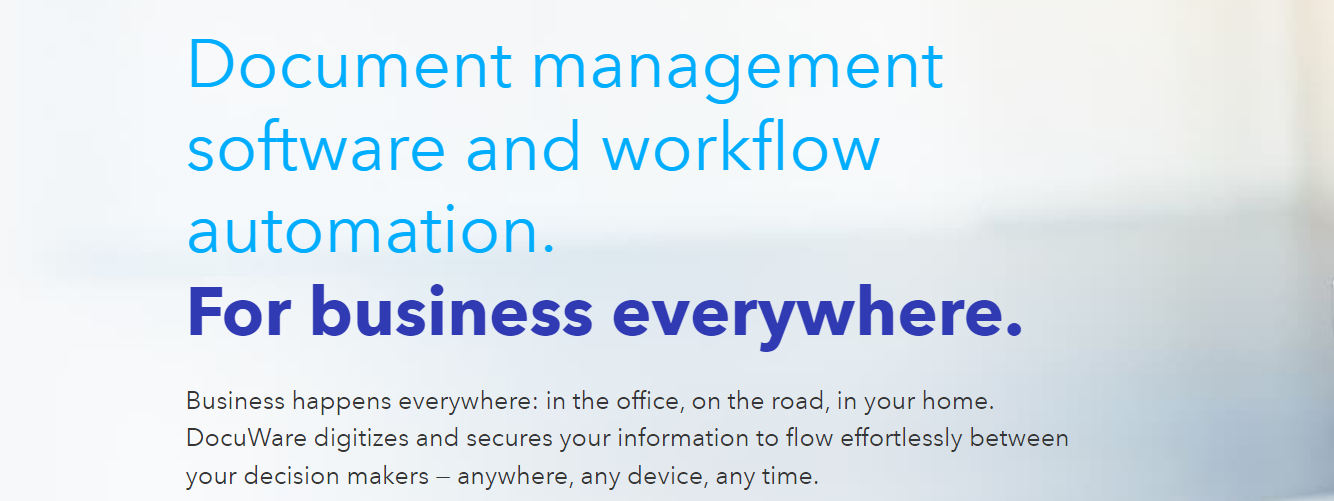
DocuWare transforms document management with its versatile platform, optimizing workflows for businesses. Offering seamless digitization, storage, and retrieval of documents, it empowers efficient collaboration and compliance. With robust security measures, DocuWare simplifies data access, fostering productivity while ensuring integrity and regulatory adherence in document handling.
Best for: Version control.
Key features:
- Version control: Tracking and managing document versions and changes.
- Document management: Digitization, storage, and retrieval of documents.
- Workflow automation: Streamlining and automating document-related processes.
- Secure storage: Safe and organized storage of documents with access control.
- Document capture: Scanning and digitizing physical documents for storage.
Pros:
- Quick and easy document search and retrieval.
- Offers accessibility and document management via mobile devices.
- Ensures regulatory compliance and data integrity.
Cons:
- Does not offer pricing information on the website.
Pricing: DocuWare demo request.
Notion

Notion redefines productivity by blending note-taking, task management, and collaboration in one platform. Its flexible workspace adapts to individual needs, fostering creativity and organization. With databases, pages, and multimedia integration, Notion offers an intuitive space for teams and individuals to ideate, plan, and execute projects seamlessly.
Best for: Document collaboration.
Key features:
- Note-taking: Rich-text editing for creating and organizing notes.
- Task management: To-do lists, kanban boards, and task tracking.
- Database: Creation of databases for structured information storage.
- Collaboration: Real-time collaboration and team workspace sharing.
- Knowledge base: Centralized repository for team knowledge and documentation.
Pros:
- There are integrations for scheduling and organizing tasks and events.
- Offers pre-designed templates for various use cases like project management, personal planning, etc.
- Allows for the embedding of files, images, videos, and more within notes.
- Has a flexible layout and structure customization for workspace organization.
Cons:
- There are limited options for exporting data outside of Notion.
- Offline access is very limited.
Pricing: Notion pricing page.
Google Drive

Google Drive is a robust cloud storage and collaboration platform. Offering ample space for files, it facilitates seamless file sharing and synchronization across devices. With integrated apps like Docs, Sheets, and Slides, it enables real-time collaboration, fostering productivity and easy access to documents, spreadsheets, and presentations.
Best for: Document storage.
Key features:
- Cloud storage: Ample storage space for documents, photos, videos, and more.
- File sharing: Effortless sharing of files and folders with specific people or groups.
- File syncing: Synchronization across devices for easy access and updates.
- Version history: Tracks and manages different versions of files for easy recovery or review.
- Security measures: Encryption and access control for secure file storage and sharing.
Pros:
- Offers generous free and paid storage options.
- Works well with various third-party apps for expanded functionality.
- Allows simultaneous editing and commenting on documents.
Cons:
- Sharing files might raise issues with ownership and control.
- There is a limited amount of storage in the free version.
Pricing: Free!
Jotform

Jotform is a platform made for document creation, empowering users to design versatile and customizable forms without coding. Offering seamless integration, it collects data effortlessly, streamlining workflows for businesses and individuals. With diverse templates and user-friendly design, Jotform simplifies data collection and boosts productivity effortlessly.
Best for: Document creation.
Key features:
- Form builder: Intuitive drag-and-drop form creation without coding.
- Templates: Diverse pre-designed templates for various form types.
- Customization: Versatile design options for personalized forms.
- Widgets: Additional elements for form enhancement, like payment fields or file uploads.
- Conditional logic: Dynamic and interactive forms based on user responses.
Pros:
- Offers encryption and secure data handling for privacy.
- Provides insights into form submission data and trends.
- Offers a free plan.
- The creation and management of forms is optimized for mobile devices.
Cons:
- There are constraints on file upload size in certain plans.
- Customization options are more limited compared to other tools.
Pricing: Jotform pricing page.
Box

Box is a cloud content management platform, changing how businesses handle data. Offering secure file storage and sharing, it empowers seamless collaboration and accessibility across devices. With focus on security and compliance, Box fosters efficient workflows, enabling teams to organize, share, and manage content effortlessly.
Best for: Content management.
Key features:
- Workflow automation: Automated workflows for efficient content management.
- Compliance: Ensuring regulatory compliance and data integrity.
- File storage: Ample cloud storage for documents, images, videos, and more.
- File sharing: Effortless sharing and collaboration on files and folders.
- Access control: Granular control over file access permissions and settings.
Pros:
- Tracks and manages different versions of files for easy recovery.
- Offers lots of cloud storage for files and documents.
- Automated workflows make content and document management easier.
Cons:
- Managing large numbers of files could be challenging without proper organization.
Pricing: Box pricing page.
Adobe Document Cloud

Adobe Document Cloud offers a comprehensive solution for document management, seamlessly digitizing workflows. It simplifies document creation, editing, and sharing, enhancing collaboration and productivity. With a focus on security and accessibility, it transforms the way businesses handle documents, empowering efficiency and compliance in the digital realm.
Best for: Document workflows.
Key features:
- Adobe Acrobat DC: Create, edit, and convert PDFs across devices.
- Document storage: Cloud storage for easy access to PDFs and other documents.
- E-signature: Legally binding e-signatures for document approvals.
- PDF collaboration: Real-time collaboration and commenting on PDFs.
- PDF editing: Comprehensive tools for editing and manipulating PDFs.
Pros:
- It can convert various file types to PDF and vice versa.
- Automates processes for document routing and approvals.
- Integrates with all other Adobe produces.
Cons:
- There are limits on storage capacity that might be restrictive for heavy users.
Pricing: Adobe Document Cloud pricing page.
Payment processing
PayPal

PayPal is a leading online payment platform that simplifies transactions globally. Offering secure and convenient payments, it enables individuals and businesses to send, receive, and manage funds effortlessly. With user-friendly interfaces and extensive reach, PayPal revolutionizes online commerce, fostering trust and reliability in digital transactions worldwide.
Best for: Global transactions.
Key features:
- Online payments: Send and receive payments globally.
- Payment gateway: Securely process payments on websites and apps.
- Peer-to-peer payments: Instantly send money to friends or family.
- Seller protection: Safeguarding sellers against unauthorized payments.
- Buyer protection: Assuring buyers of secure transactions and refunds.
Pros:
- Offers quick and easy checkout for online purchases.
- Generates and sends invoices for services or products.
- Facilitates transactions in multiple currencies.
- Widely accepted and used for online transactions worldwide.
Cons:
- Resolution processes might favor buyers over sellers.
Pricing: PayPal pricing page.
Stripe
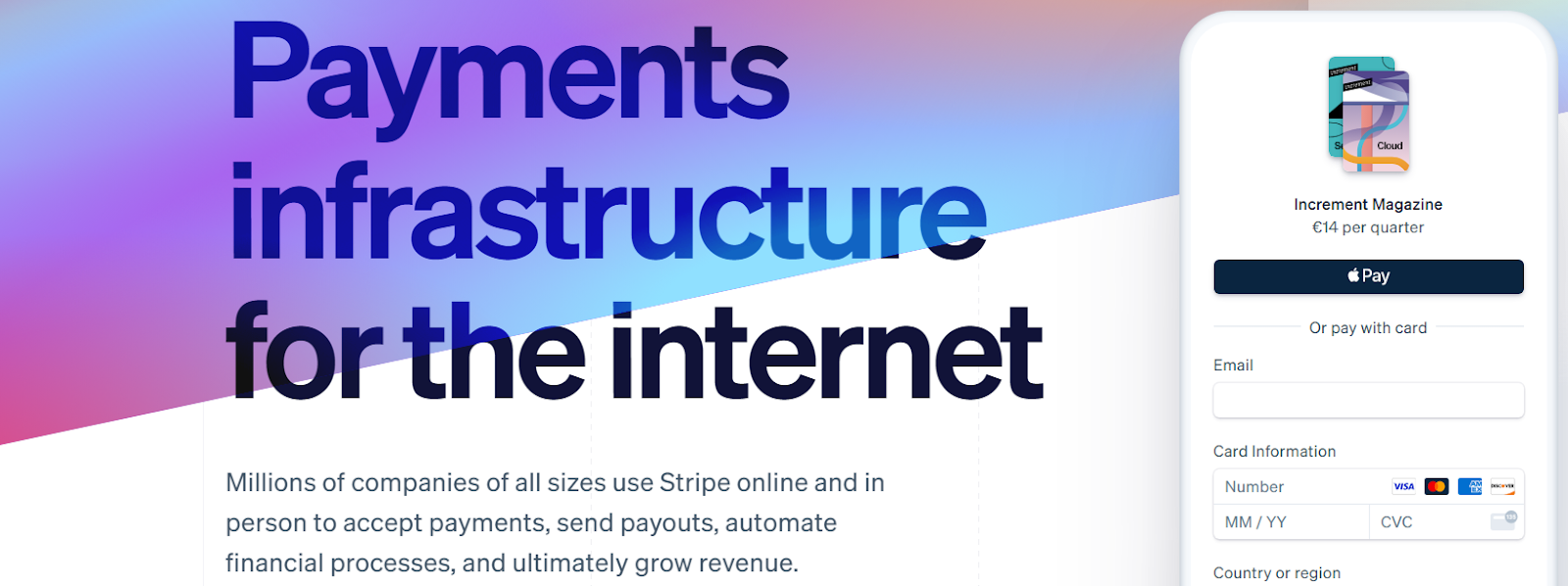
Stripe is a versatile online payment platform that allows businesses to accept and manage transactions globally. Its developer-friendly tools and secure infrastructure simplifies payment processing. With flexible APIs and robust analytics, Stripe streamlines e-commerce, enabling swift and reliable payment handling, fostering growth in digital commerce.
Best for: Developers.
Key features:
- Payment processing: Accept and manage online payments securely.
- Developer tools: Developer-friendly APIs and documentation for easy integration.
- Recurring billing: Subscription and recurring payment management.
- Invoicing: Create and send invoices for services or products.
- Fraud prevention: Robust tools to prevent and manage fraudulent activities.
Pros:
- Securely processes payments on websites and apps.
- Accepts payments through mobile devices.
- Processes payments in multiple currencies and countries.
- Offers comprehensive insights into transaction data.
Cons:
- There are occasional holds or freezes on accounts for security purposes.
- Transaction fees might be higher compared to some other payment processors.
Pricing: Stripe pricing page.
Payoneer

Payoneer provides a borderless financial platform for businesses and freelancers worldwide. Renowned for its ease of use and swift transactions, it simplifies cross-border payments and empowers users to manage finances seamlessly. With its versatility, Payoneer facilitates secure and efficient international transactions effortlessly.
Best for: Paying international freelancers.
Key features:
- Payment request: Enables requesting payments from clients or marketplaces.
- Bank transfers: Transfers funds to local bank accounts globally.
- Prepaid mastercard: Access funds via a prepaid Mastercard for transactions.
- Billing service: Invoicing and billing solutions for businesses.
- Multi-currency account: Holds balances in different currencies.
Pros:
- Facilitates cross-border payments in multiple currencies.
- Simplifies mass payments to multiple recipients.
- Securely holds funds for transactions until completion.
- Has tools for tax compliance and management for businesses.
Cons:
- Transaction fees and currency conversion charges might be relatively higher.
- Disputes might take time to resolve.
Pricing: Payoneer pricing page.
WePay
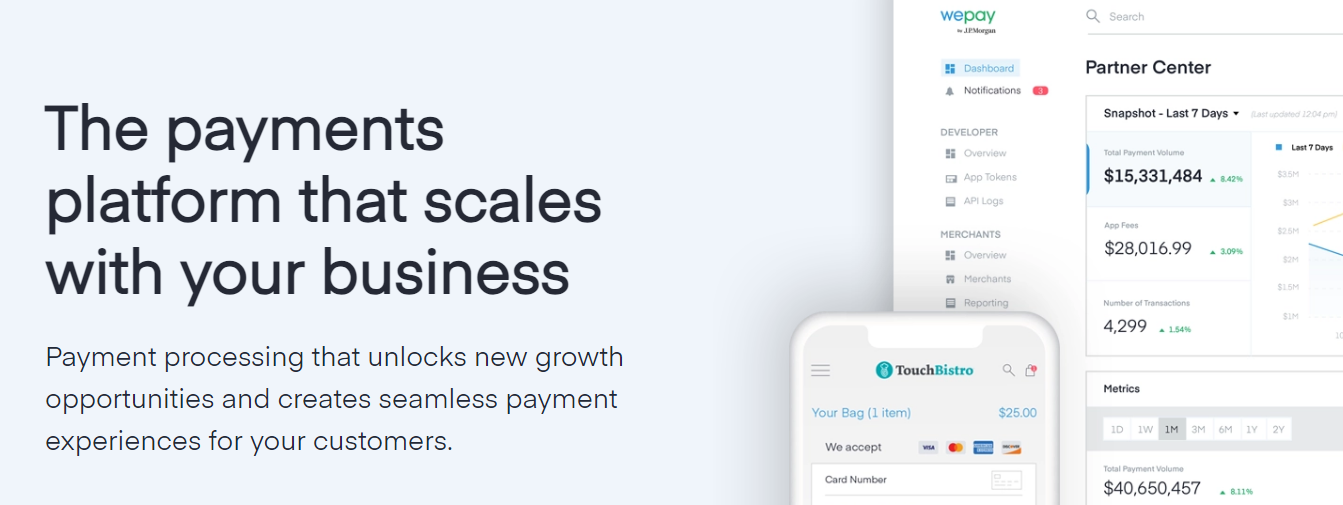
WePay offers seamless payment solutions tailored for platforms and marketplaces. Known for its simplicity and customization, it simplifies payments for online businesses. With a focus on easy integration and user experience, WePay enables platforms to handle transactions securely, fostering growth and reliability in digital commerce.
Best for: Online payments.
Key features:
- Customizable checkout: Tailored checkout experiences for businesses.
- Platform integration: Easy integration with various platforms and marketplaces.
- Fraud and risk protection: Tools to mitigate fraudulent activities and manage risks.
- APIs and SDKs: Developer tools for seamless integration and customization.
- Bank account verification: Securely verifies bank accounts for transactions.
Pros:
- Facilitates secure online payment transactions.
- Supports various digital wallet payments for convenience.
- Has tools for managing subscription-based models.
- Is really great for developers.
Cons:
- Services might be limited in certain regions or countries.
- Supports fewer payment methods compared to some other processors.
Pricing: WePay contact page.
2Checkout

2Checkout, a robust e-commerce payment platform, simplifies global transactions for businesses. Its versatility and international reach allows secure online payments in various currencies. With a focus on user-friendly experiences and reliability, 2Checkout facilitates swift and trustworthy digital commerce, fostering growth for enterprises worldwide.
Best for: E-commerce payments.
Key features:
- Global reach: Facilitates transactions in multiple currencies and countries.
- Subscription management: Tools for managing subscription-based models.
- Payment methods: Supports various payment methods for customer convenience.
- Recurring billing: Automates and manages recurring payments.
- Fraud prevention: Tools to detect and prevent fraudulent activities.
Pros:
- Has integrations with various e-commerce platforms.
- Offers tools for easy integration and customization.
- Gives insights into transaction data and performance.
Cons:
- Processing times for withdrawals are sometimes slower than other tools.
Pricing: 2Checkout pricing page.
Adyen

Adyen streamlines secure payments in various industries. With a focus on user experience and flexibility, Adyen empowers enterprises with seamless and reliable payment processing, fostering growth and trust.
Best for: Diverse industries.
Key features:
- Unified commerce solution: Single platform for in-store, online, and mobile payments.
- Global payment methods: Supports various payment methods across regions.
- Multi-currency support: Processes payments in multiple currencies.
- Risk management: Tools for fraud detection and prevention.
- POS solutions: Payment solutions for in-store and point-of-sale transactions.
Pros:
- Handles recurring payments and subscriptions.
- Gives comprehensive insights into transaction data.
- Is an ideal solution for restaurants and retail.
Cons:
- The features and pricing are better suited to larger businesses.
Pricing: Adyen pricing page.
Clover
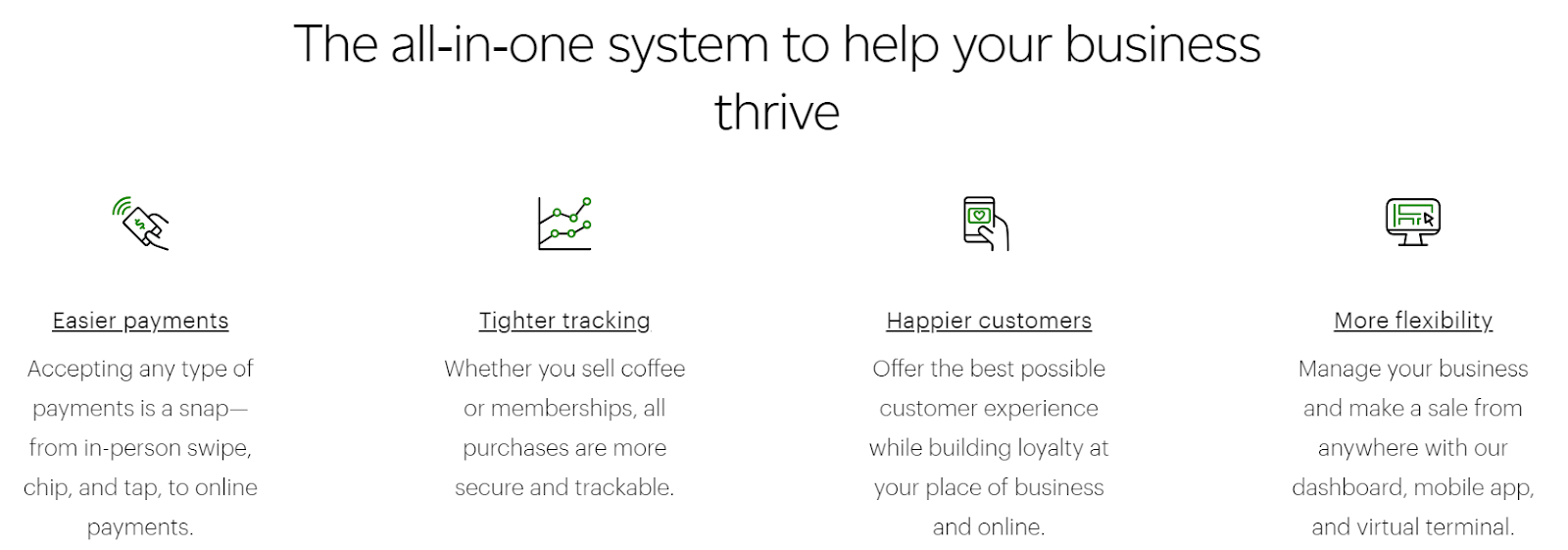
Clover, a comprehensive point-of-sale (POS) system, improves business transactions with its versatile solutions. It streamlines payment processing for various industries. With a focus on scalability and innovation, Clover enhances customer experiences and empowers businesses to thrive in digital commerce.
Best for: POS systems.
Key features:
- Point-of-sale (POS): Comprehensive POS systems for businesses.
- Inventory management: Tracks and manages inventory levels and sales.
- Customer management: Stores customer information and preferences.
- Employee management: Tracks employee time and performance.
- Ordering and delivery: Facilitates order management and delivery.
Pros:
- Offers adaptable POS hardware for different business needs.
- Ensures secure transactions and data protection.
- Accepts various payment methods securely.
Cons:
- Switching systems might be challenging due to proprietary hardware and software.
Pricing: Clover pricing page.
Opayo

Opayo is a leading payment service provider that streamlines online transactions with its secure and efficient solutions. Renowned for its reliability and adaptability, it empowers businesses with seamless payment processing. With a focus on user-friendly interfaces and robust security measures, Opayo facilitates trust and growth in digital commerce effortlessly.
Best for: UK online businesses.
Key features:
- Multi-currency: Accepts payments in various currencies.
- Fraud prevention: Tools for detecting and preventing fraudulent transactions.
- Recurring billing: Manages and automates recurring payments.
- Tokenization: Secures payment data through tokenization for future transactions.
- Integration: Integrates with various e-commerce platforms and systems.
Pros:
- Provides insights into transaction data and performance.
- Ensures secure payment transactions and data protection.
- Facilitates payments through mobile devices.
- Offers assistance and support for users and businesses.
Cons:
- Is not the best solution for businesses outside the UK.
- There are limited customization options for specific needs.
Pricing: Opayo contact page.
Inventory management
Fishbowl

Fishbowl is a platform that optimizes inventory control and streamlines operations. With a focus on user-friendly interfaces and customization, Fishbowl empowers enterprises, fostering efficiency and growth in inventory management.
Best for: Inventory control.
Key features:
- Inventory management: Comprehensive tools for tracking and managing inventory.
- Order management: Streamlines order processing and fulfillment.
- Warehouse management: Organizes and optimizes warehouse operations.
- Manufacturing: Supports manufacturing processes and workflows.
- Barcoding: Enables barcode scanning for inventory tracking.
Pros:
- Manages inventory across multiple locations.
- Automates alerts for inventory reordering.
- Has customizable user access and permissions.
- Integrates with various accounting and e-commerce platforms.
Cons:
- Some users report challenges with customer service responsiveness.
- Hardware and software requirements might be demanding.
Pricing: Fishbowl pricing page.
Katana

Katana supports manufacturers and crafters with its intuitive manufacturing and inventory management tools. Renowned for its scalability, it optimizes production processes, streamlines workflows, and offers real-time insights. With a focus on craft industries, Katana simplifies operations, fostering growth and efficiency seamlessly.
Best for: Craft industries.
Key features:
- Production planning: Efficient planning and scheduling of production activities.
- Order fulfillment: Streamlines order processing and fulfillment.
- Bill of materials (BOM): Creation and management of bill of materials.
- Real-time inventory updates: Provides real-time updates on inventory levels.
- Multi-channel sales: Integrates with various sales channels and platforms.
Pros:
- Enables barcode scanning for inventory tracking.
- Manages purchasing and supplier relationships.
- Provides insights into production and sales data.
- Integrates with various accounting and e-commerce platforms.
Cons:
- Pricing might be a concern for some smaller businesses.
- Might not cater comprehensively to industries outside manufacturing and craft sectors.
Pricing: Katana pricing page.
Odoo

Odoo’s inventory management streamlines operations with real-time tracking, efficient order fulfillment, and seamless warehouse management. With features like barcode scanning, automated reordering, and flexible reporting, it optimizes inventory control. Its user-friendly interface and integration capabilities empower businesses with comprehensive control and visibility over stock.
Best for: A suite of business products.
Key features:
- Multiple locations: Manages inventory across multiple warehouses or locations.
- Automated reordering: Sets automatic triggers for replenishing stock.
- Batch and serial number tracking: Tracks items using batch or serial numbers.
- Inventory valuation: Calculates inventory value using different costing methods.
- FIFO and LIFO: Supports First-In, First-Out, and Last-In, First-Out methods.
Pros:
- Facilitates easy movement of inventory between locations.
- Seamlessly integrates with other Odoo modules and third-party applications.
- Tracks inventory levels and locations in real-time.
- Efficient inventory management through barcode scanning.
Cons:
- Can be expensive, especially when adding numerous modules or users.
- Highly customized needs might require additional development.
Pricing: Odoo pricing page.
Lightspeed

Lightspeed is an intuitive POS and e-commerce platform that empowers businesses with streamlined operations. It optimizes retail and restaurant management. With a focus on efficiency and innovation, Lightspeed simplifies transactions, inventory, and customer engagement, fostering growth in diverse industries.
Best for: POS inventory management.
Key features:
- POS: Streamlines in-store and online transactions.
- Inventory management: Tracks and manages inventory across locations.
- E-commerce integration: Synchronizes in-store and online sales.
- Customer management: Stores customer information and preferences.
- Reporting and analytics: Provides insights into sales and inventory data.
Pros:
- Streamlines ordering and supplier management.
- Tracks employee schedules and performance.
- Accepts various payment methods securely.
- Tailored for retail, restaurant, and e-commerce needs.
Cons:
- Isn’t a great tool for manufacturing industries.
- Can be relatively expensive, especially for smaller businesses.
Pricing: Lightspeed pricing page.
Megaventory

Megaventory is a cloud-based inventory management solution that optimizes inventory control and order fulfillment. With a user-friendly interface and extensive capabilities, Megaventory simplifies inventory processes, fostering growth and efficiency effortlessly.
Best for: Order fulfillment.
Key features:
- Inventory management: Tracks and manages inventory levels.
- Order management: Streamlines order processing and fulfillment.
- Supplier management: Manages relationships with suppliers.
- Purchase and sales orders: Creates and manages purchase and sales orders.
- Inventory costing: Calculates inventory costs using different methods.
Pros:
- Efficient inventory management using barcodes.
- Offers customizable access and permissions for users.
- Integrates with various accounting and e-commerce platforms.
Cons:
- Some users report challenges with customer service responsiveness.
Pricing: Megaventory pricing page.
Sortly

Sortly simplifies inventory management with its intuitive platform. Popular for its adaptability, it optimizes organization and tracking of items across industries. With a focus on efficiency and customization, Sortly empowers businesses to streamline inventory operations effortlessly, fostering growth and productivity.
Best for: Budget inventory management.
Key features:
- Inventory tracking: Efficient tracking of inventory items.
- Barcode scanning: Facilitates inventory management through barcode scanning.
- Customized labels: Creates custom labels for items.
- Multi-location support: Manages inventory across multiple locations.
- Alerts and notifications: Notifies about low stock or reorder points.
Pros:
- Accessible from anywhere with internet connectivity.
- Works seamlessly on mobile devices.
- Integrates with other business software and platforms.
Cons:
- Might lack some advanced functionalities for complex needs.
Pricing: Sortly pricing page.
Asset Panda

Asset Panda is a comprehensive asset tracking platform that simplifies inventory management. Renowned for its adaptability and robustness, it offers a seamless solution for businesses. With a focus on flexibility and customization, Asset Panda makes asset tracking and management across various industries super easy.
Best for: Asset tracking.
Key features:
- Asset tracking: Tracks and manages assets throughout their lifecycle.
- Customizable fields: Allows custom fields to adapt to unique asset information.
- Barcode scanning: Efficiently manages assets through barcode scanning.
- Maintenance management: Schedules and tracks asset maintenance tasks.
- Check-in/check-out: Tracks asset movement and usage history.
Pros:
- Helps businesses scale.
- Monitors asset locations across various sites.
- Provides insights into asset data and utilization.
- Highly customizable to fit unique asset tracking needs.
Cons:
- Extensive customization might be complex for some users.
- Pricing only available upon request.
Pricing: Asset Panda pricing page.
Acumatica

Acumatica’s inventory management optimizes operations by efficiently tracking, organizing, and controlling inventory. It offers multi-location support, barcode scanning, and automated processes. With features for forecasting and cost control, Acumatica empowers businesses to streamline inventory operations and enhance productivity effortlessly.
Best for: Inventory organization.
Key features:
- Financial management: Comprehensive tools for managing finances and accounting.
- Inventory management: Efficiently tracks and manages inventory.
- Order management: Streamlines order processing and fulfillment.
- Purchase order management: Manages purchasing processes and orders.
- Workflow automation: Automates various business processes.
Pros:
- Manages multiple business entities within a single system.
- Offers comprehensive tools for managing finances and accounting.
- Manages customer relationships and interactions.
- Tracks project costs and revenues.
Cons:
- Some users face integration issues with certain systems or platforms.
- Pricing is only available upon request.
Pricing: Acumatica pricing request.
Take advantage of the free things
Just about every single one of the tools on this massive list offers something for free. A free trial, a free demo, a free plan, you name it. Take advantage of all of it! Use them as a way to help you find the best tools for your business so it can thrive.
Happy shopping!







